Cisco Linksys WRT55AG Dual-Band Wireless A+G Broadband Router User Manual WRT55AG ug Rev NC
Cisco-Linksys, LLC Dual-Band Wireless A+G Broadband Router WRT55AG ug Rev NC
Contents
User manual part 5
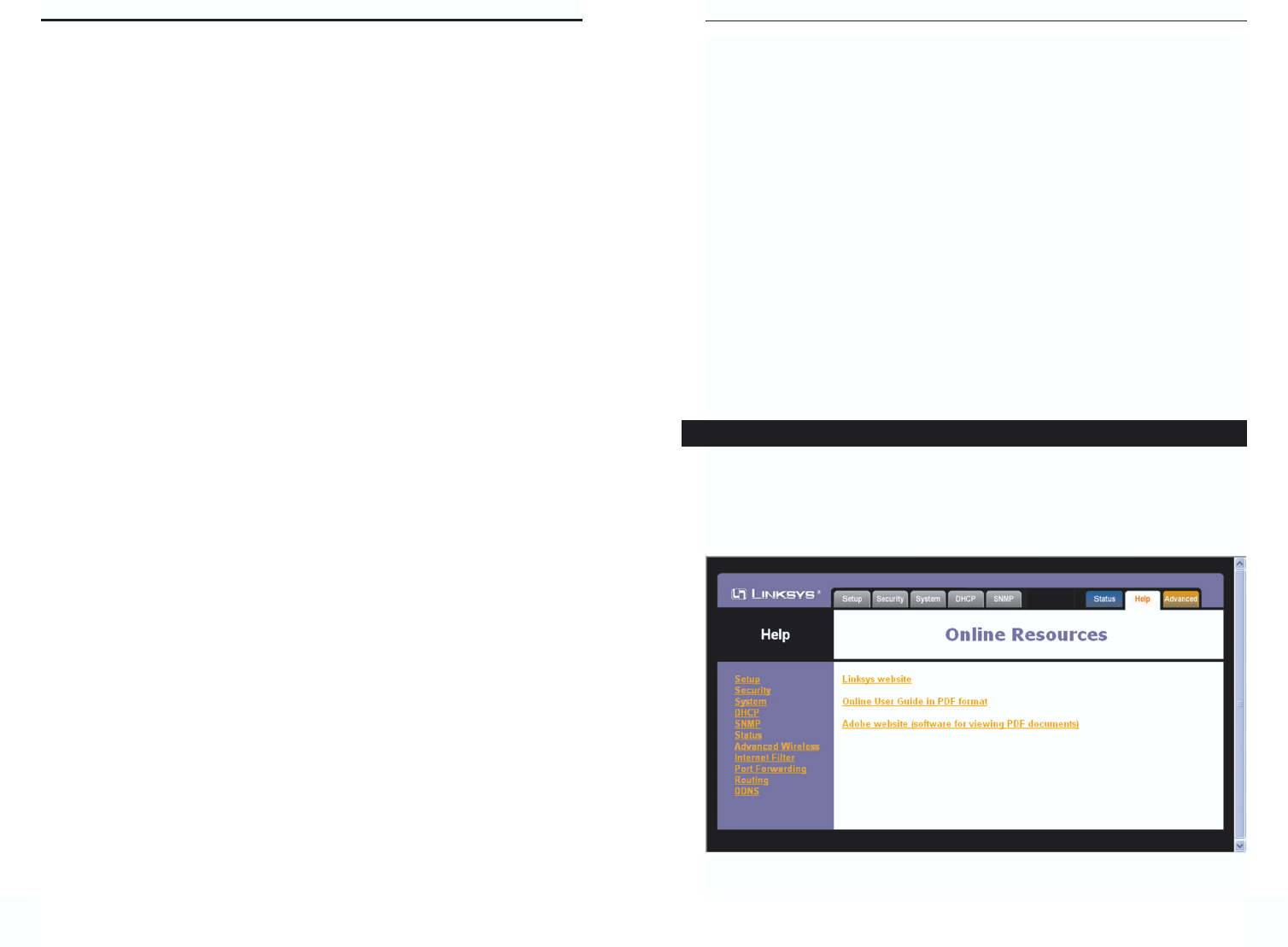
Internet
Configuration Type The type of Internet connection is displayed here.
Status For PPPoE or PPTP, the status of the Internet connection is displayed
here. If there is no connection, you can click the Connect button to re-estab-
lish it. If there is a connection, you can click the Disconnect button to end it.
IP Address, Subnet Mask, and Default Gateway The Router’s IP Address,
Subnet Mask, and Default Gateway Address, as seen by external users on the
Internet, are displayed here.
DNS The DNS (Domain Name System) IP Addresses currently used by the
Router are shown here. Multiple DNS IP settings are common. In most cases,
the first available DNS entry is used.
To refresh the Status screen, click the Refresh button. To get more information
about the features, click the Help button.
The Help screen, shown in Figure 7-19, offers links to all of the Router’s tech-
nical support resources and the application that upgrades the Router’s
firmware. For additional information about each screen of the web-based util-
ity, click the appropriate link on the lefthand side of the Help screen.
55
Instant Wireless®Series
54
Dual-Band Wireless A+G Broadband Router
Firmware Version The version number of the firmware currently installed is
displayed here.
Current Time The current time, as set from the Setup tab, is displayed here.
Host Name The Host Name is the name of the Router. This entry is necessary
for some ISPs.
Domain Name The Domain Name is the name of the Router's domain. This
entry is necessary for some ISPs.
LAN
IP Address and Subnet Mask The current IP Address and Subnet Mask of
the Router, as seen by users on your local area network (LAN), are displayed
here.
DHCP Server The status of the Router's DHCP server function is displayed
here.
Wireless 5GHz, 802.11a
Mode The Mode setting, as set from the Setup tab, is displayed here.
SSID The SSID of the 5GHz, 802.11a network is displayed here.
Channel The channel for the 5GHz, 802.11a wireless network is displayed
here.
Encryption Function The status of the WEP encryption is displayed here.
Wireless 2.4GHz, Wireless-G
Mode The Mode setting, as set from the Setup tab, is displayed here.
SSID The SSID of the 2.4GHz, 802.11b network is displayed here.
Channel The channel for the 2.4GHz, 802.11b wireless network is displayed
here.
Encryption Function The status of the WEP encryption is displayed here.
Help
Figure 7-19
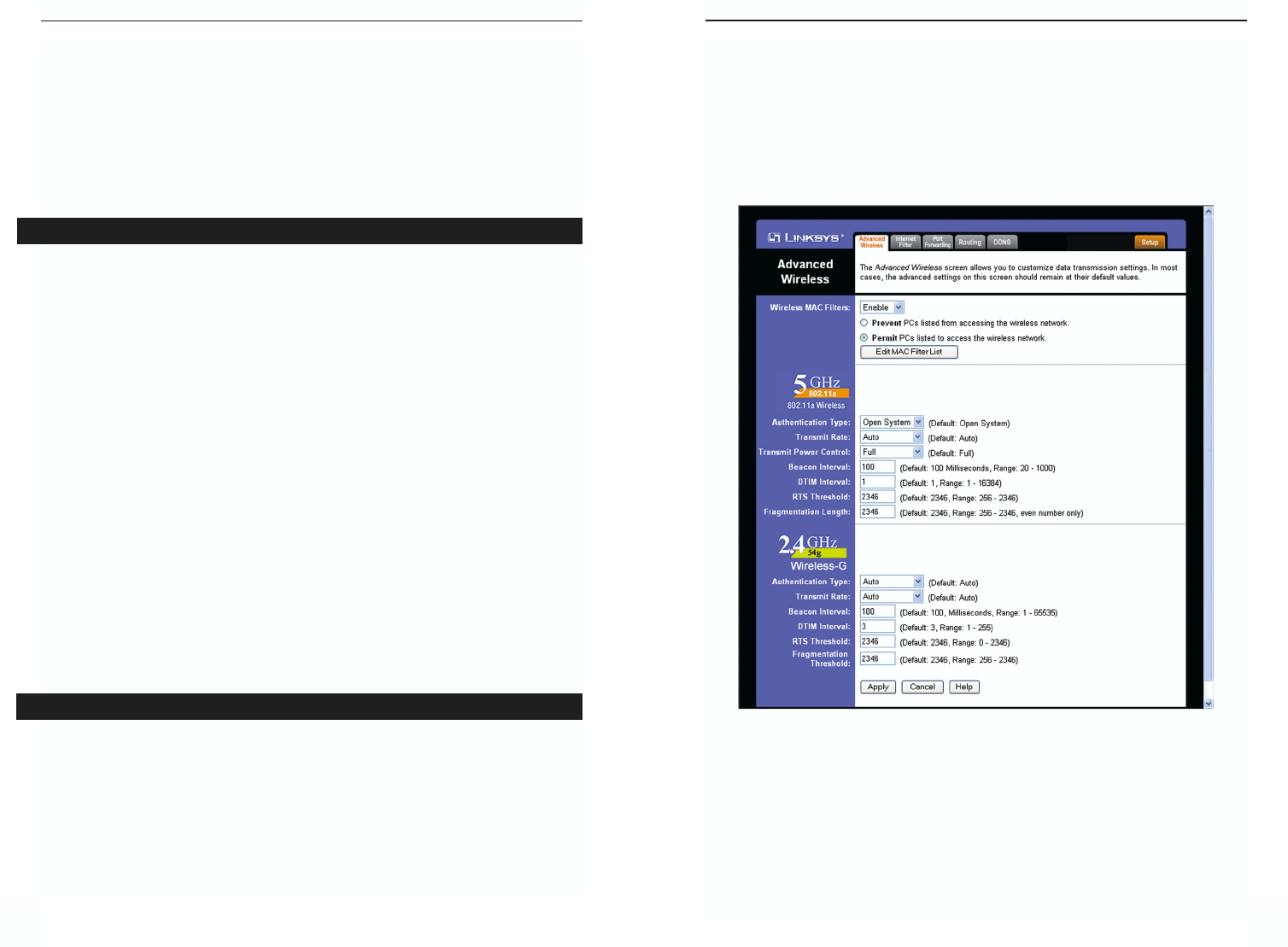
Dual-Band Wireless A+G Broadband Router
Wireless MAC Filters
Wireless access can be filtered by using the MAC addresses of the wireless
devices transmitting within your network’s radius. Select Enable from the drop-
down menu and choose if you wish to Prevent wireless access by MAC address
or Permit by MAC Address. Then, click the Edit MAC Filter List button to
access a secondary screen, where you can enter the MAC Addresses of the
devices you wish to filter.
5GHz, 802.11a
Authentication Type The default is set to Auto, which allows either Open
System or Shared Key authentication to be used. For Open System authentica-
tion, the sender and the recipient do NOT use a WEP key for authentication.
For Shared Key authentication, the sender and recipient use a WEP key for
authentication. If you want to use only Shared Key authentication, then select
Shared Key.
57
Figure 7-20
Linksys Website Clicking this link will take you to Linksys’s website,
www.linksys.com, provided you are connected to the Internet.
Online User Guide in PDF Format and Adobe Website Clicking the Online
User Guide in PDF format link opens the Router’s User Guide. The User
Guide is in Adobe Acrobat Portable Document File (.pdf) format, so you need
the Adobe Acrobat Reader to view it. If you do not have the Acrobat Reader,
click the Adobe website link to download it.
The following instructions are for advanced users or users whose setup needs
require special configuration. When you click the Advanced tab, you will be
able to set up these features. There are six additional tabs available.
Advanced Wireless - Allows you to customize data transmission and 802.1x
settings for your wireless network(s).
Internet Filter - Enables you to set up filters that block specific internal users
from Internet access.
Port Forwarding - Lets you set up public services on your network, such as an
ftp server, mail server, or web server.
Routing - Enables you to configure the routing mode of the Router.
DDNS - Allows you to enable the Dynamic Domain Name System (DDNS)
feature, so a fixed domain name can be assigned to a dynamic Internet IP
address.
If you need to access the basic configuration tabs, click the Setup tab.
The Advanced Wireless screen, shown in Figure 7-20, allows you to customize
data transmission settings. In most cases, the advanced wireless settings on this
screen should remain at their default values.
56
Instant Wireless®Series
Advanced Tabs
Advanced Wireless

Dual-Band Wireless A+G Broadband Router
59
Transmission Rate The rate of data transmission should be set depending on
the speed of your wireless network. You can select from a range of transmission
speeds (6, 9, 12, 18, 24, 36, 48, or 54Mbps), or you can select Auto to have the
Router automatically use the fastest possible data rate and enable the Auto-
Fallback feature. Auto-Fallback will negotiate the best possible connection
speed between the Router and a wireless client. The default value is Auto.
Transmit Power Control The greater the transmit power used, the larger the
area a wireless network covers. To minimize the likelihood of eavesdropping by
unauthorized wireless users, do not use more transmit power than necessary to
cover the range needed for your wireless network. Try using the Router at dif-
ferent levels of transmit power, and determine how much transmit power is
needed to reach the wireless client, such as a PC, or access point that is farthest
from the Router. Then select the appropriate level of transmit power (Full,
Half, Quarter, Eighth, or Min) from the drop-down menu. The default value
is Full.
Beacon Interval The default value is 100. Enter a value between 1 and 65,535
milliseconds. The Beacon Interval value indicates the frequency interval of the
beacon. A beacon is a packet broadcast by the Router to synchronize the wire-
less network.
DTIM Interval This value, between 1 and 16384, indicates the interval of the
Delivery Traffic Indication Message (DTIM). A DTIM field is a countdown
field informing clients of the next window for listening to broadcast and mul-
ticast messages. When the Router has buffered broadcast or multicast messages
for associated clients, it sends the next DTIM with a DTIM Interval value. Its
clients hear the beacons and awaken to receive the broadcast and multicast mes-
sages. The default value is 1.
RTS Threshold Should you encounter inconsistent data flow, only minor
reduction of the default value, 2346, is recommended. If a network packet is
smaller than the preset RTS threshold size, the RTS/CTS mechanism will not
be enabled. The Router sends Request to Send (RTS) frames to a particular
receiving station and negotiates the sending of a data frame. After receiving an
RTS, the wireless station responds with a Clear to Send (CTS) frame to
acknowledge the right to begin transmission. The RTS Threshold value should
remain at its default value of 2346.
58
Fragmentation Threshold This value specifies the maximum size for a pack-
et before data is fragmented into multiple packets. If you experience a high
packet error rate, you may slightly increase the Fragmentation Threshold.
Setting the Fragmentation Threshold too low may result in poor network per-
formance. Only minor reduction of the default value is recommended. In most
cases, it should remain at its default value of 2346.
2.4GHz, 54g/Wireless-G
Authentication Type The default is set to Auto, which allows either Open
System or Shared Key authentication to be used. For Open System authentica-
tion, the sender and the recipient do NOT use a WEP key for authentication.
For Shared Key authentication, the sender and recipient use a WEP key for
authentication. If you want to use only Shared Key authentication, then select
Shared Key.
Transmission Rate The rate of data transmission should be set depending on
the speed of your wireless network. You can select from a range of transmission
speeds (6, 9, 12, 18, 24, 36, 48, or 54Mbps), or you can select Auto to have the
Router automatically use the fastest possible data rate and enable the Auto-
Fallback feature. Auto-Fallback will negotiate the best possible connection
speed between the Router and a wireless client. The default value is Auto.
Beacon Interval The Beacon Interval value indicates the frequency interval of
the beacon. Enter a value between 20 and 1000. A beacon is a packet broadcast
by the Router to synchronize the wireless network. The default value is 100.
DTIM Interval This value, between 1 and 16384, indicates the interval of the
Delivery Traffic Indication Message (DTIM). A DTIM field is a countdown
field informing clients of the next window for listening to broadcast and mul-
ticast messages. When the Router has buffered broadcast or multicast messages
for associated clients, it sends the next DTIM with a DTIM Interval value. Its
clients hear the beacons and awaken to receive the broadcast and multicast mes-
sages. The default value is 1.
RTS Threshold Should you encounter inconsistent data flow, only minor
reduction of the default value, 2346, is recommended. If a network packet is
smaller than the preset RTS threshold size, the RTS/CTS mechanism will not
be enabled. The Router sends Request to Send (RTS) frames to a particular
receiving station and negotiates the sending of a data frame. After receiving an
RTS, the wireless station responds with a Clear to Send (CTS) frame to
acknowledge the right to begin transmission. The RTS Threshold value should
remain at its default value of 2346.
Instant Wireless®Series
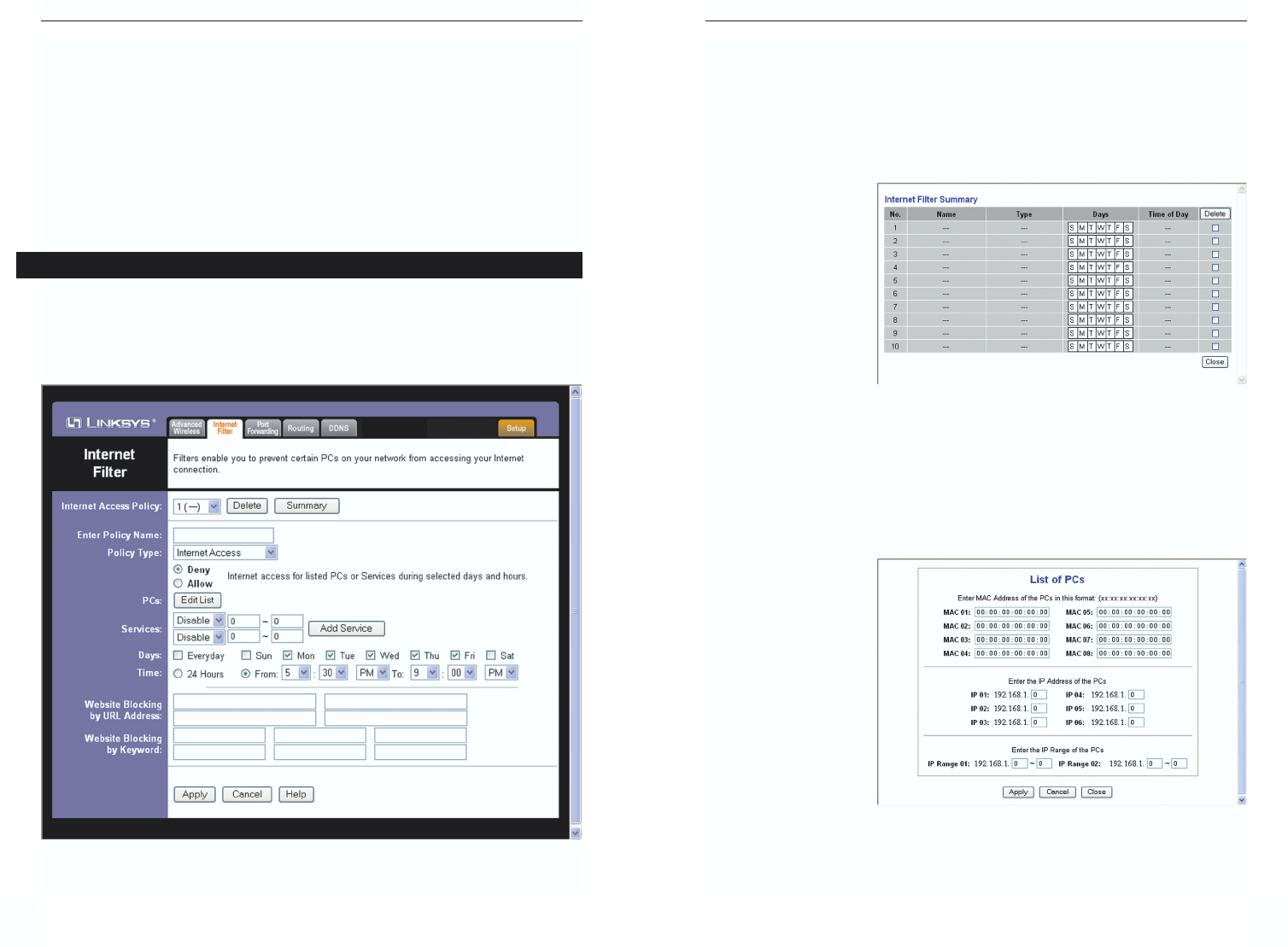
Internet Access Policy Multiple Filters can be saved as Internet Access
Policies. When you wish to edit one, select the number of the Policy from the
drop-down menu. The tab will change to reflect the settings of this Policy. If
you wish to delete this Policy, click the Delete button.
To see a summary of all Policies, click the Summary button.
The summaries are list-
ed on this screen,
shown in Figure 7-22,
with their name and
settings. To delete any
summary from this
screen, check the
empty box beneath
Delete and then click
the Delete button. To
return to the Filters tab,
click the Close button.
Enter Policy Name Policies are created from the fields presented here. To
create a policy:
1. Enter a Policy Name in the field provided.
2. Click the Edit List
of PCs button. This
will open the List of
PCs screen, shown
in Figure 7-23.
From this screen,
you can enter the IP
address or MAC
address of any PC
to which this policy
will apply. You can
even enter ranges of
PCs by IP address.
Click the Apply
button to save your settings, the Cancel button to undo any changes, and the
Close button to return to the Filters tab.
61
Dual-Band Wireless A+G Broadband Router
Fragmentation Threshold This value specifies the maximum size for a pack-
et before data is fragmented into multiple packets. If you experience a high
packet error rate, you may slightly increase the Fragmentation Threshold.
Setting the Fragmentation Threshold too low may result in poor network per-
formance. Only minor reduction of this value is recommended. In most cases,
it should remain at its default value of 2346.
To apply any of the settings you change on this page, click the Apply button.
To cancel any changes you’ve entered on this page, click the Cancel button. To
get more information about the features, click the Help button.
The Internet Filter tab, shown in Figure 7-21, allows you to block or allow spe-
cific kinds of Internet usage. You can set up Internet access policies for specif-
ic PCs and set up filters by using network port numbers.
60
Instant Wireless®Series
Internet Filter
Figure 7-21
Figure 7-22
Figure 7-23
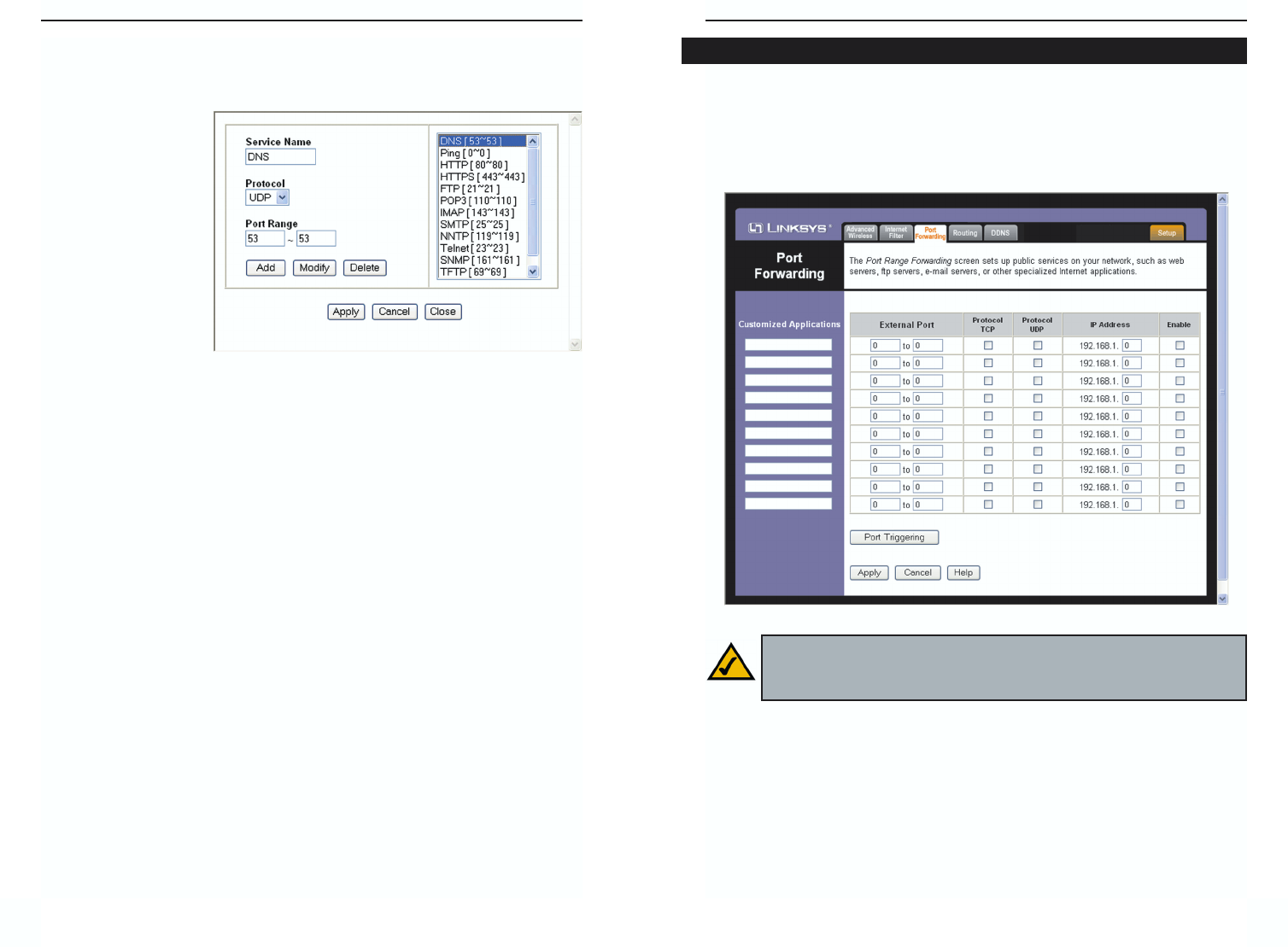
Dual-Band Wireless A+G Broadband Router
63
The Port Forwarding screen, shown in Figure 7-25, sets up public services on
your network, such as web servers, ftp servers, e-mail servers, or other spe-
cialized Internet applications. (Specialized Internet applications are any appli-
cations that use Internet access to perform functions such as videoconferencing
or online gaming. Some Internet applications may not require any forwarding.)
Customized Applications In the field provided, enter the name you wish to
give each application.
External Port For each application, enter the number of the External Ports
(the port numbers seen by users on the Internet) in the appropriate fields. (To
find out the port range, check your application’s documentation.) If there is
only one External Port, enter its number in both External Port fields.
Port Forwarding
Figure 7-25
Note: Any PC whose port is being forwarded should have its DHCP
client function disabled and a new static IP address assigned to it
because its IP address may change when using the DHCP function.
Instant Wireless®Series
62
3. Select if you wish to Disable or Enable Internet access for those PCs you
listed on the List of PCs screen by clicking the radio button beside either
option.
4. You can filter
access to various
services accessed
over the Internet,
such as FTP or
Telnet, by selecting
a service from the
pull-down menus
next to Services. If
a service isn’t listed,
you can click the
Add Service button
to open the Service
screen, shown in Figure 7-24, and add a service to the list. You will need to
enter a Service name, as well as the Protocol and Port Range used by the
service.
5. By selecting the appropriate setting next to Days and Time, choose when
Internet access will be filtered.
6. Lastly, click the Apply button to save and activate this policy.
Internet Access can also be filtered by URL Address, the address entered to
access Internet sites, by entering the address in one of the Website Blocking
by URL Address fields. If you do not know the URL Address, filtering can be
done by Keyword by entering a keyword in one of the Website Blocking by
Keyword fields.
To apply any of the settings you change on this page, click the Apply button. To
cancel any changes you’ve entered on this page, click the Cancel button. To get
more information about the features, click the Help button.
Figure 7-24
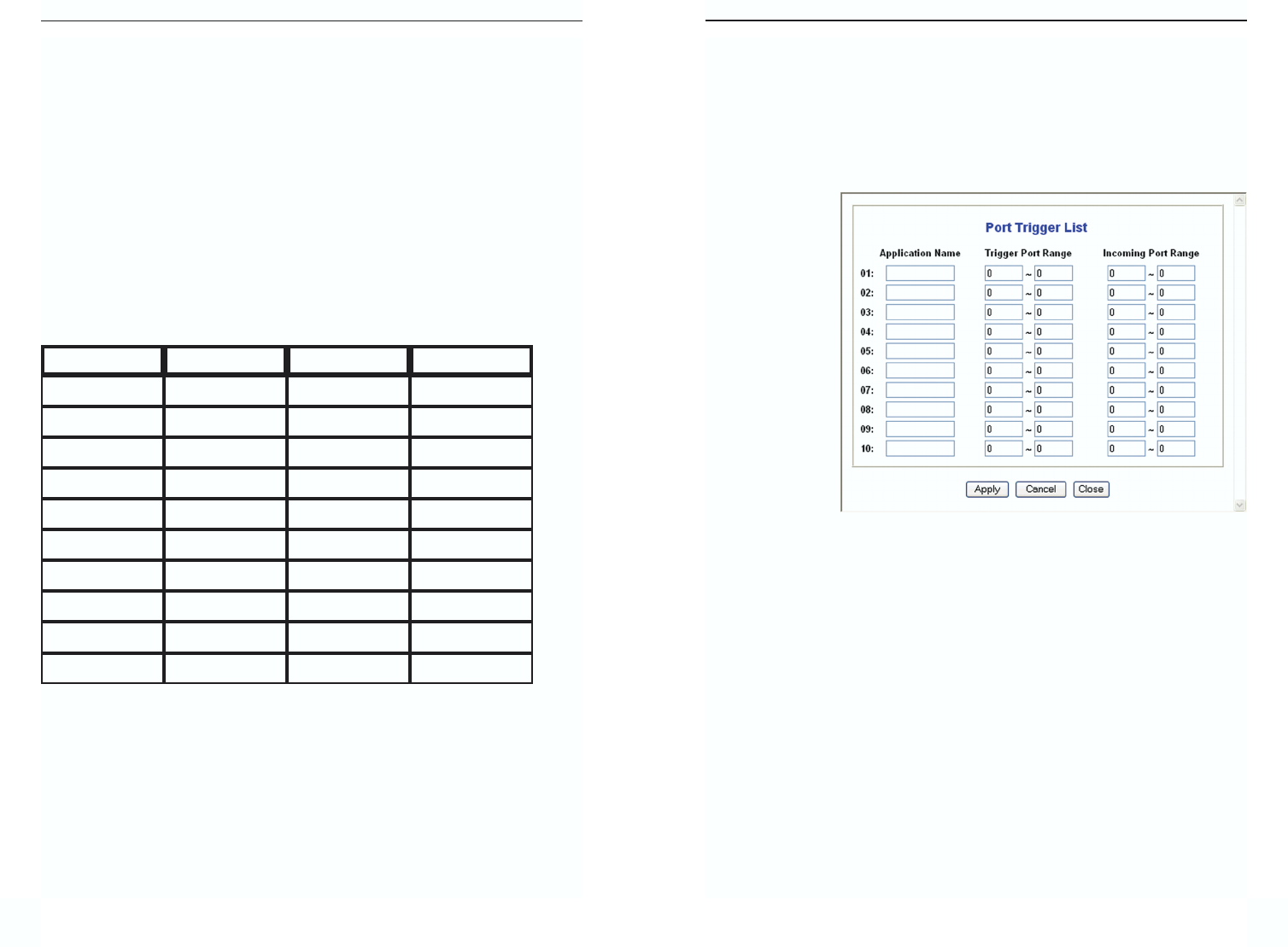
Dual-Band Wireless A+G Broadband Router
65
Protocol TCP Click this checkbox if you want to forward the data transmis-
sions that use the TCP protocol.
Protocol UDP Click this checkbox if you want to forward the data transmis-
sions that use the UDP protocol.
IP Address For each application, enter the IP Address of the PC running the
specific application.
Enable Click the Enable checkbox to enable port forwarding for the relevant
application.
The following table shows the typical port forwarding settings for common
Internet applications.
To apply any of the settings you change on this page, click the Apply button. To
cancel any changes you’ve entered on this page, click the Cancel button. To get
more information about the features, click the Help button.
64
Instant Wireless®Series
FTP
Applications External Port TCP Protocol UDP Protocol
21 √
Telnet 23 √
SMTP 25 √
DNS 53 √
TFTP 69 √
Finger 79 √
HTTP 80 √
POP3 110 √
NNTP 119 √
SNMP 161 √
Port Triggering Port Triggering is used for special Internet applications whose
outgoing ports differ from the incoming ports. For this feature, the Router will
watch outgoing data for specific port numbers. The Router will remember the
IP address of the computer that sends a transmission requesting data, so that
when the requested data returns through the Router, the data is pulled back to
the proper computer by way of IP address and port mapping rules. Click the
Port Triggering button to set up triggered ports, and follow these instructions:
1. Enter the
Application
Name of the
trigger (see
Figure 7-26).
2. Enter the Outgoing Port Range used by the application. Check with the
Internet application for the port number(s) needed.
3. Enter the Incoming Port Range used by the application. Check with the
Internet application for the port number(s) needed.
4. Click the Apply button to save your changes. Click the Cancel button to
cancel your unsaved changes. Click the Close button to return to the Port
Forwarding screen.
To save your changes on this page, click the Apply button. To cancel any
unsaved changes on this page, click the Cancel button. To get more informa-
tion about the features, click the Help button.
Figure 7-26
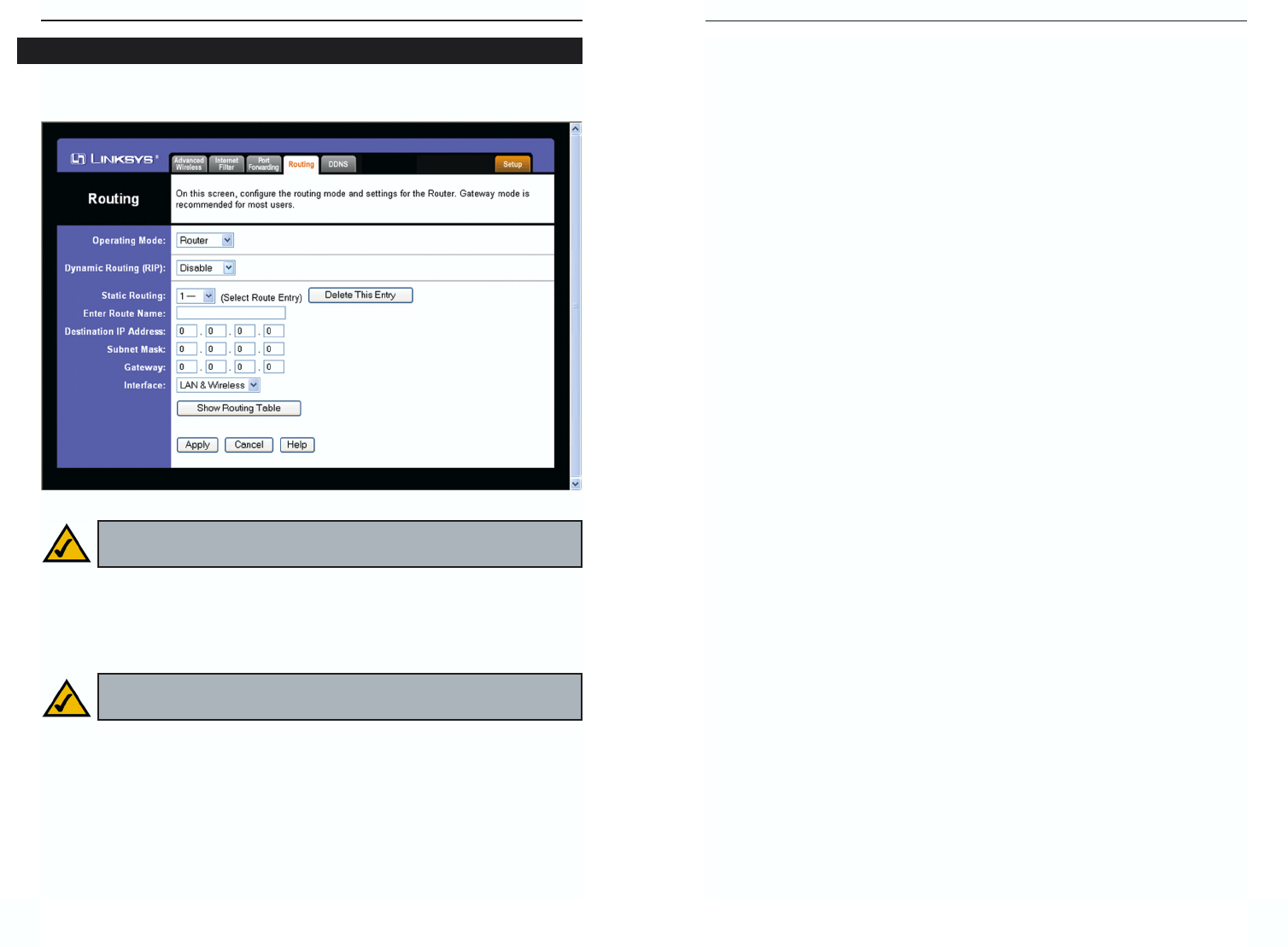
67
Instant Wireless®Series
66
Dual-Band Wireless A+G Broadband Router
4. To set up a static route between the Router and another network, select a
number from the Static Routing drop-down list. (A static route is a pre-
determined pathway that network information must travel to reach a spe-
cific host or network.)
5. Enter the following data:
• Enter Route Name - Enter a name for the Route here, using a maxi-
mum of 25 alphanumeric characters.
• Destination LAN IP - The Destination LAN IP is the address of the
remote network or host to which you want to assign a static route.
• Subnet Mask - The Subnet Mask determines which portion of a
Destination LAN IP address is the network portion, and which portion
is the host portion.
• Gateway - This is the IP address of the gateway device that allows for
contact between the Router and the remote network or host.
•Interface - This interface tells you whether the Destination IP Address
is on the LAN & Wireless (internal wired and wireless networks), the
WA N (Internet), or Loopback (a dummy network in which one PC
acts like a network-necessary for certain software programs).
6. To cancel your changes, click the Cancel button. To save your changes,
click the Apply button. To get more information about the features, click
the Help button.
To delete a static route entry:
1. From the Static Routing drop-down list, select the entry number of the stat-
ic route.
2. Click the Delete This Entry button.
3. To cancel a deletion, click the Cancel button. To save a deletion, click the
Apply button. To get more information about the features, click the Help
button.
On the Routing screen, shown in Figure 7-27, you can set the routing mode of
the Router. Gateway mode is recommended for most users.
To set up routing:
1. Choose the correct working mode. Select Gateway if the Router is hosting
your network’s connection to the Internet (recommended for most users).
Select Router if the Router exists on a network with other routers.
2. If you selected the Gateway mode, click the Apply button. If you selected
the Router mode, proceed to step 3.
3. For Dynamic Routing, the default is Disable. The Dynamic Routing feature
enables the Router to automatically adjust to physical changes in the net-
work’s layout and exchange routing tables with the other router(s). The
Router determines the network packets’ route based on the fewest number
of hops between the source and the destination. Select Enable to enable the
Dynamic Routing feature for data transmissions.
Routing
Figure 7-27
Note: The Routing screen and available features will vary depending
on which mode you select.
Note: If you have more than one router on your network, you should
select Router for the working mode.
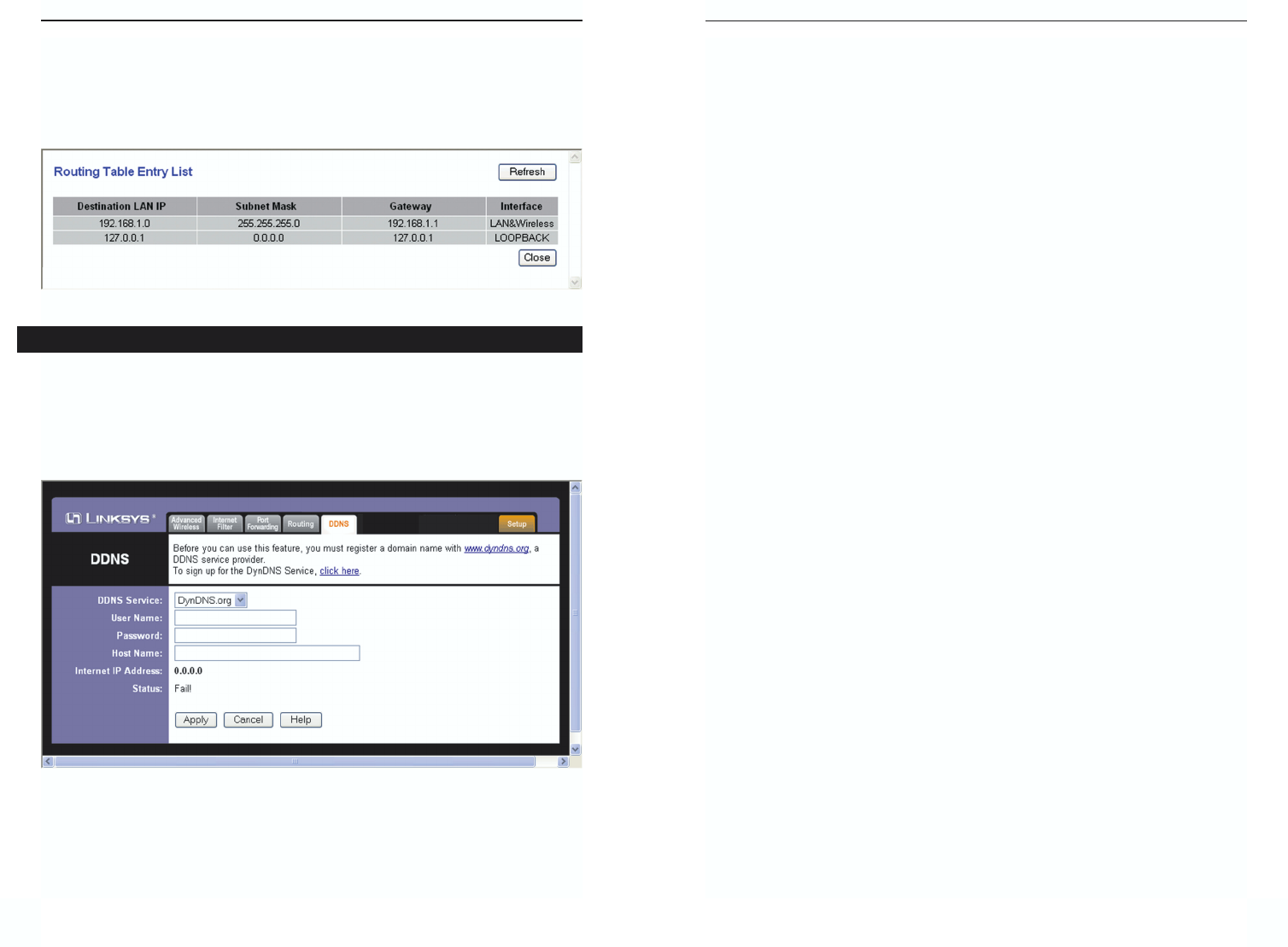
69
Instant Wireless®Series
68
Dual-Band Wireless A+G Broadband Router
Show Routing Table Click the Show Routing Table button to view all of the
valid dynamic and static route entries in use (see Figure 7-28). The Destination
LAN IP address, Subnet Mask, Gateway, and Interface information are dis-
played for each entry. Click the Refresh button to display the most up-to-date
data.
The Router offers a Dynamic Domain Name System (DDNS) feature. DDNS
lets you assign a fixed host and domain name to a dynamic Internet IP address.
It is useful when you are hosting your own website, FTP server, or other serv-
er behind the Router. Before you can use this feature, you need to sign up for
DDNS service at www.dyndns.org, or www.TZO.com, DDNS service providers.
Figure 7-28
DDNS Service To enable DDNS Service, select Enable and follow these
instructions:
1. Sign up for a DDNS service and write down your User Name, Password,
and Host Name information.
2. On the DDNS screen, select Enable.
3. Complete the User Name, Password, and Host Name fields.
4. To save your new settings, click the Apply button. To cancel your changes,
click the Cancel button.
Internet IP Address The Router’s current Internet IP Address is displayed
here.
Status The status of the DDNS service connection is displayed here.
To save your changes on this page, click the Apply button. To cancel any
unsaved changes on this page, click the Cancel button. To get more information
about the features, click the Help button.
DDNS
Figure 6-27

For Windows 2000:
A. Click Start, Settings, and Control Panel. Double-click Network and
Dial-Up Connections.
B. Right-click the Local Area Connection that is associated with the Ethernet
adapter you are using, and select the Properties option.
C. In the Components checked are used by this connection box, highlight
Internet Protocol (TCP/IP), and click the Properties button. Select Use
the following IP address option.
D. Enter a unique IP address that is not used by any other computer on the
network connected to the Router. You can only use an IP address in the
ranges 192.168.1.2 to 192.168.1.99 and 192.168.1.151 to 192.168.1.254.
E. Enter the Subnet Mask, 255.255.255.0.
F. Enter the Default Gateway, 192.168.1.1 (Router’s default IP address).
G. Toward the bottom of the window, select Use the following DNS server
addresses, and enter the Preferred DNS server and Alternative DNS
server (provided by your ISP). Contact your ISP or go on its website to find
the information.
H. Click the OK button in the Internet Protocol (TCP/IP) Properties window,
and click the OK button in the Local Area Connection Properties window.
I. Restart the computer if asked.
For Windows NT 4.0:
A. Click Start, Settings, and Control Panel. Double-click the Network icon.
B. Click the Protocol tab, and double-click TCP/IP Protocol.
C. When the window appears, make sure you have selected the correct
Adapter for your Ethernet adapter.
D. Select Specify an IP address, and enter a unique IP address that is not
used by any other computer on the network connected to the Router. You
can only use an IP address in the ranges 192.168.1.2 to 192.168.1.99 and
192.168.1.151 to 192.168.1.254.
E. Enter the Subnet Mask, 255.255.255.0.
F. Enter the Default Gateway, 192.168.1.1 (Router’s default IP address).
G. Click the DNS tab, and enter the Host and Domain names (e.g., John for
Host and home for Domain). Under DNS Service Search Order, click the
Add button. Enter the DNS IP address in the DNS Server field, and click
the Add button. Repeat this action for all DNS IP addresses given by your
ISP.
H. Click the OK button in the TCP/IP Protocol Properties window, and click
the Close button in the Network window.
I. Restart the computer if asked.
71
Instant Wireless®Series
70
Dual-Band Wireless A+G Broadband Router
Appendix A: Troubleshooting
This appendix consists of two parts: “Common Problems and Solutions” and
“Frequently Asked Questions.” Provided are possible solutions to problems that
may occur during the installation and operation of the Router. Read the descrip-
tions below to help solve your problems. If you can’t find an answer here, check
the Linksys website at www.linksys.com.
1. I need to set a static IP address on a PC.
The Router, by default, assigns an IP address range of 192.168.1.100 to
192.168.1.150 using the DHCP server on the Router. To set a static IP address,
you can only use the ranges 192.168.1.2 to 192.168.1.99 and 192.168.1.151 to
192.168.1.254. Each PC or network device that uses TCP/IP must have a
unique address to identify itself in a network. If the IP address is not unique to
a network, Windows will generate an IP conflict error message. You can assign
a static IP address to a PC by performing the following steps:
For Windows 98 and Me:
A. Click Start, Settings, and Control Panel. Double-click Network.
B. In The following network components are installed box, select the TCP/IP->
associated with your Ethernet adapter. If you only have one Ethernet adapter
installed, you will only see one TCP/IP line with no association to an Ethernet
adapter. Highlight it and click the Properties button.
C. In the TCP/IP properties window, select the IP address tab, and select
Specify an IP address. Enter a unique IP address that is not used by any
other computer on the network connected to the Router. You can only use
an IP address in the ranges 192.168.1.2 to 192.168.1.99 and 192.168.1.151
to 192.168.1.254. Make sure that each IP address is unique for each PC or
network device.
D. Click the Gateway tab, and in the New Gateway prompt, enter 192.168.1.1,
which is the default IP address of the Router. Click the Add button to accept
the entry.
E. Click the DNS tab, and make sure the DNS Enabled option is selected.
Enter the Host and Domain names (e.g., John for Host and home for
Domain). Enter the DNS entry provided by your ISP. If your ISP has not
provided the DNS IP address, contact your ISP to get that information or go
to its website for the information.
F. Click the OK button in the TCP/IP properties window, and click Close or
the OK button for the Network window.
G. Restart the computer when asked.
Common Problems and Solutions

73
Instant Wireless®Series
72
Dual-Band Wireless A+G Broadband Router
B. Open a command prompt.
• For Windows 98 and Me, please click Start and Run. In the Open field,
type in command. Press the Enter key or click the OK button.
• For Windows NT, 2000, and XP, please click Start and Run. In the
Open field, type cmd. Press the Enter key or click the OK button.
C. In the command prompt, type ping 192.168.1.1 and press the Enter key.
• If you get a reply, the computer is communicating with the Router.
• If you do NOT get a reply, please check the cable, and make sure Obtain
an IP address automatically is selected in the TCP/IP settings for your
Ethernet adapter.
D. In the command prompt, type ping followed by your Internet or WAN IP
address and press the Enter key. The Internet or WAN IP Address can be
found on the Status screen of the Router’s web-based utility. For example,
if your Internet or WAN IP address is 1.2.3.4, you would enter ping 1.2.3.4
and press the Enter key.
• If you get a reply, the computer is connected to the Router.
• If you do NOT get a reply, try the ping command from a different com-
puter to verify that your original computer is not the cause of the problem.
E. In the command prompt, type ping www.yahoo.com and press the Enter
key.
• If you get a reply, the computer is connected to the Internet. If you can-
not open a webpage, try the ping command from a different computer to
verify that your original computer is not the cause of the problem.
• If you do NOT get a reply, there may be a problem with the connection.
Try the ping command from a different computer to verify that your orig-
inal computer is not the cause of the problem.
3. I am not getting an IP address on the Internet with my Internet connection.
A. Refer to “Problem #2, I want to test my Internet connection” to verify that
you have connectivity.
B. If you need to register the MAC address of your Ethernet adapter with your
ISP, please see “Appendix D: Finding the MAC address and IP Address for
Your Ethernet Adapter.” If you need to clone the MAC address of your
Ethernet adapter onto the Router, see the MAC Address Clone section of
“Chapter 7: The Router’s Web-based Utility” for details.
C. Make sure you are using the right Internet connection settings. Contact your
ISP to see if your Internet connection type is DHCP, Static IP Address, or
PPPoE (commonly used by DSL consumers). Please refer to the Setup sec-
tion of “Chapter 7: The Router’s Web-based Utility” for details on Internet
connection settings.
For Windows XP:
The following instructions assume you are running Windows XP with the
default interface. If you are using the Classic interface (where the icons and
menus look like previous Windows versions), please follow the instructions for
Windows 2000.
A. Click Start and Control Panel.
B. Click the Network and Internet Connections icon and then the Network
Connections icon.
C. Right-click the Local Area Connection that is associated with the Ethernet
adapter you are using, and select the Properties option.
D. In the This connection uses the following items box, highlight Internet
Protocol (TCP/IP). Click the Properties button.
E. Enter a unique IP address that is not used by any other computer on the net-
work connected to the Router. You can only use an IP address in the ranges
192.168.1.2 to 192.168.1.99 and 192.168.1.151 to 192.168.1.254.
F. Enter the Subnet Mask, 255.255.255.0.
G. Enter the Default Gateway, 192.168.1.1 (Router’s default IP address).
H. Toward the bottom of the window, select Use the following DNS server
addresses, and enter the Preferred DNS server and Alternative DNS
server (provided by your ISP). Contact your ISP or go on its website to find
the information.
I. Click the OK button in the Internet Protocol (TCP/IP) Properties window.
Click the OK button in the Local Area Connection Properties window.
2. I want to test my Internet connection.
A. Check your TCP/IP settings.
For Windows 98, Me, 2000, and XP:
Refer to “Chapter 4: Configure the PCs” for details. Make sure Obtain IP
address automatically is selected in the settings.
For Windows NT 4.0:
• Click Start, Settings, and Control Panel. Double-click the Network
icon.
• Click the Protocol tab, and double-click on TCP/IP Protocol.
• When the window appears, make sure you have selected the correct
Adapter for your Ethernet adapter and set it for Obtain an IP address
from a DHCP server.
• Click the OK button in the TCP/IP Protocol Properties window, and
click the Close button in the Network window.
• Restart the computer if asked.

of the web interface. If you assigned a static IP address to any computer or net-
work device on the network, you need to change its IP address accordingly to
192.168.2.Y (Y being any number from 1 to 254). Note that each IP address
must be unique within the network.
Your VPN may require port 500/UDP packets to be passed to the computer that
is connecting to the IPSec server. Refer to “Problem #7, I need to set up online
game hosting or use other Internet applications” for details.
Check the Linksys website for more information at www.linksys.com.
6. I need to set up a server behind my Router.
To use a server like a web, ftp, or mail server, you need to know the respective
port numbers they are using. You can get more information by viewing the doc-
umentation provided with the server you installed. Follow these steps to set up
port forwarding through the Router’s web-based utility. We will be setting up
web, ftp, and mail servers.
A. Access the Router’s web-based utility by going to http://192.168.1.1 or the
IP address of the Router. Go to the Advanced => Port Forwarding tab.
B. Enter any name you want to use for the Customized Application.
C. Enter the External Port range of the service you are using. For example,
if you have a web server, you would enter the range 80 to 80.
D. Check the protocol you will be using, TCP and/or UDP.
E. Enter the IP address of the PC or network device that you want the port
server to go to. For example, if the web server’s Ethernet adapter IP address
is 192.168.1.100, you would enter 100 in the field provided. Check
“Appendix D: Finding the MAC Address and IP Address for Your Ethernet
Adapter” for details on getting an IP address.
F. Check the Enable option for the port services you want to use. Consider the
example below:
Customized External Port TCP UDP IP Address Enable
Application
Web server 80 to 80 X X 192.168.1.100 X
FTP server 21 to 21 X 192.168.1.101 X
SMTP (outgoing) 25 to 25 X X 192.168.1.102 X
POP3 (incoming) 110 to 110 X X 192.168.1.102 X
When you have completed the configuration, click the Apply button.
75
Instant Wireless®Series
74
Dual-Band Wireless A+G Broadband Router
D. Make sure you have the right cable. Check to see if the Internet column has
a solidly lit Link/Act LED.
E. Make sure the cable connecting from your cable or DSL modem is con-
nected to the Router’s Internet port. Verify that the Status page of the
Router’s web-based utility shows a valid IP address from your ISP.
F. Turn off the computer, Router, and cable/DSL modem. Wait 30 seconds,
and then turn on the Router, cable/DSL modem, and computer. Check the
Status tab of the Router’s web-based utility to see if you get an IP address.
4. I am not able to access the Setup page of the Router’s web-based utility.
A. Refer to “Problem #2, I want to test my Internet connection” to verify that
your computer is properly connected to the Router.
B. Refer to “Appendix D: Finding the MAC Address and IP address for Your
Ethernet Adapter” to verify that your computer has an IP Address, Subnet
Mask, Gateway, and DNS.
C. Set a static IP address on your system; refer to “Problem #1: I need to set a
static IP address.”
D. Refer to “Problem #10: I need to remove the proxy settings or the dial-up
pop-up window (for PPPoE users).”
5. I can’t get my Virtual Private Network (VPN) working through the Router.
Access the Router’s web interface by going to http://192.168.1.1 or the IP
address of the Router, go to the System tab. Make sure you have IPsec pass-
through, L2TP, and PPTP pass-through enabled.
VPNs that use IPSec with the ESP (Encapsulation Security Payload known as
protocol 50) authentication will work fine. At least one IPSec session will work
through the Router; however, simultaneous IPSec sessions may be possible,
depending on the specifics of your VPNs.
VPNs that use IPSec and AH (Authentication Header known as protocol 51)
are incompatible with the Router. AH has limitations due to occasional incom-
patibility with the NAT standard.
Change the IP address for the Router to another subnet to avoid a conflict
between the VPN IP address and your local IP address. For example, if your
VPN server assigns an IP address 192.168.1.X (X is a number from 1 to 254)
and your local LAN IP address is 192.168.1.X (X is the same number used in
the VPN IP address), the Router will have difficulties routing information to
the right location. If you change the Router’s IP address to 192.168.2.1, that
should solve the problem. Change the Router’s IP address through the Setup tab

settings. If the port number that the data enters from does not have port for-
warding, then the Router will send the data to whichever PC or network device
you set for DMZ hosting.) Follow these steps to set DMZ hosting:
A. Access the Router’s web-based utility by going to http://192.168.1.1 or the
IP address of the Router. Go to the Advanced => Port Forwarding tab.
B. Disable or remove the entries you have entered for forwarding. Keep this
information in case you want to use it at a later time.
C. Click the Security tab and select DMZ Host.
D. Enter the Ethernet adapter’s IP address of the computer you want exposed
to the Internet. This will bypass the NAT firewall for that computer. Please
refer to “Appendix D: Finding the MAC Address and IP Address for Your
Ethernet Adapter” for details on getting an IP address.
Once completed with the configuration, click the Apply button.
9. I forgot my password, or the password prompt always appears when I am sav-
ing settings to the Router.
Reset the Router to factory default by pressing the Reset button for 10 seconds
and then releasing it. If you are still getting prompted for a password when sav-
ing settings, then perform the following steps:
A. Access the Router’s web-based utility by going to http://192.168.1.1 or the
IP address of the Router. Enter the default password admin, and click the
Security tab.
B. Enter a different password in the Router Password field, and enter the
same password in the second field to confirm the password.
C. Click the Apply button.
10. I am a PPPoE user, and I need to remove the proxy settings or the dial-up pop-
up window.
If you have proxy settings, you need to disable these on your computer.
Because the Router is the gateway for the Internet connection, the computer
does not need any proxy settings to gain access. Please follow these directions
to verify that you do not have any proxy settings and that the browser you use
is set to connect directly to the LAN.
For Microsoft Internet Explorer 5.0 or higher:
A. Click Start, Settings, and Control Panel. Double-click Internet Options.
B. Click the Connections tab.
C. Click the LAN settings button and remove anything that is checked.
D. Click the OK button to go back to the previous screen.
77
Instant Wireless®Series
7. I need to set up online game hosting or use other Internet applications.
If you want to play online games or use Internet applications, most will work
without doing any port forwarding or DMZ hosting. There may be cases when
you want to host an online game or Internet application. This would require you
to set up the Router to deliver incoming packets or data to a specific comput-
er. This also applies to the Internet applications you are using. The best way to
get the information on what port services to use is to go to the website of the
online game or application you want to use. Follow these steps to set up online
game hosting or use a certain Internet application:
A. Access the Router’s web interface by going to http://192.168.1.1 or the IP
address of the Router. Go to the Advanced => Port Forwarding tab.
B. Enter any name you want to use for the Customized Application.
C. Enter the External Port range of the service you are using. For example,
if you want to host Unreal Tournament (UT), you would enter the range
7777 to 27900.
D. Check the protocol you will be using, TCP and/or UDP.
E. Enter the IP address of the PC or network device that you want the port
server to go to. For example, if the web server’s Ethernet adapter IP address
is 192.168.1.100, you would enter 100 in the field provided. Check
“Appendix D: Finding the MAC Address and IP Address for Your Ethernet
Adapter” for details on getting an IP address.
F. Check the Enable option for the port services you want to use. Consider the
example below:
Customized External Port TCP UDP IP Address Enable
Application
UT 7777 to 27900 X X 192.168.1.100 X
Halflife 27015 to 27015 X X 192.168.1.105 X
PC Anywhere 5631 to 5631 X 192.168.1.102 X
VPN IPSEC 500 to 500 X 192.168.1.100 X
When you have completed the configuration, click the Apply button.
8. I can’t get the Internet game, server, or application to work.
If you are having difficulties getting any Internet game, server, or application
to function properly, consider exposing one PC to the Internet using
DeMilitarized Zone (DMZ) hosting. This option is available when an applica-
tion requires too many ports or when you are not sure which port services to
use. Make sure you disable all the forwarding entries if you want to success-
fully use DMZ hosting, since forwarding has priority over DMZ hosting. (In
other words, data that enters the Router will be checked first by the forwarding
76
Dual-Band Wireless A+G Broadband Router

C. Perform the upgrade using the Upgrade Utility, TFTP program or Router’s
web-based utility through its Help tab.
14. My DSL service’s PPPoE is always disconnecting.
PPPoE is not actually a dedicated or always-on connection. The DSL ISP can
disconnect the service after a period of inactivity, just like a normal phone dial-
up connection to the Internet. There is a setup option to “keep alive” the con-
nection. This may not always work, so you may need to re-establish connec-
tion periodically.
A. To connect to the Router, go to the web browser, and enter
http://192.168.1.1 or the IP address of the Router.
B. Enter the password, if asked. (The default password is admin.)
C. On the Setup screen, select the option Keep Alive, and set the Redial
Period option at 30 (seconds).
D. Click the Apply button.
E. Click the Status tab, and click the Connect button.
F. You may see the login status display as Connecting. Press the F5 key to
refresh the screen, until you see the login status display as Connected.
G. Click the Apply button to continue.
If the connection is lost again, follow steps E to G to re-establish connection.
15. I can’t access my e-mail, web, or VPN, or I am getting corrupted data from the
Internet.
The Maximum Transmission Unit (MTU) setting may need to be adjusted. By
default, the MTU is set at 1400. For most DSL users, it is strongly recom-
mended to use MTU 1492. If you are having some difficulties, perform the fol-
lowing steps:
A. To connect to the Router, go to the web browser, and enter
http://192.168.1.1 or the IP address of the Router.
B. Enter the password, if asked. (The default password is admin.)
C. Click the System tab.
D. Look for the MTU option, and select Manual. In the Size field, enter 1492.
E. Click the Apply button to continue.
79
Instant Wireless®Series
E. Click the option Never dial a connection. This will remove any dial-up
pop-ups for PPPoE users.
For Netscape 4.7 or higher:
A. Start Netscape Navigator, and click Edit, Preferences, Advanced, and
Proxies.
B. Make sure you have Direct connection to the Internet selected on this
screen.
C. Close all the windows to finish.
11. To start over, I need to set the Router to factory default.
Hold the Reset button for 10 seconds and then release it. This will return the
password, forwarding, and other settings on the Router to the factory default
settings. In other words, the Router will revert to its original factory configu-
ration.
12. I need to upgrade the firmware.
In order to upgrade the firmware with the latest features, you need to go to the
Linksys website and download the latest firmware at www.linksys.com. Follow
these steps:
A. Go to the Linksys website at http://www.linksys.com and download the
latest firmware.
B. To upgrade the firmware, follow the steps in the Help section found in
“Chapter 7: The Router’s Web-based Utility.”
13. The firmware upgrade failed, and/or the Diag LED is flashing.
The upgrade could have failed for a number of reasons. Follow these steps to
upgrade the firmware and/or make the Diag LED stop flashing:
A. If the firmware upgrade failed, use the TFTP program (it was downloaded
along with the firmware). Open the pdf that was downloaded along with the
firmware and TFTP program, and follow the pdf’s instructions.
B. Set a static IP address on the PC; refer to “Problem #1, I need to set a stat-
ic IP address.” Use the following IP address settings for the computer you
are using:
IP Address: 192.168.1.50
Subnet Mask: 255.255.255.0
Gateway: 192.168.1.1
78
Dual-Band Wireless A+G Broadband Router

What is the maximum number of IP addresses that the Router will support?
The Router will support up to 253 IP addresses.
Is IPSec Pass-Through supported by the Router?
Yes, it is a built-in feature that the Router automatically enables.
Where is the Router installed on the network?
In a typical environment, the Router is installed between the cable/DSL modem
and the LAN. Plug the Router into the cable/DSL modem’s Ethernet port.
Does the Router support IPX or AppleTalk?
No. TCP/IP is the only protocol standard for the Internet and has become the
global standard for communications. IPX, a NetWare communications protocol
used only to route messages from one node to another, and AppleTalk, a com-
munications protocol used on Apple and Macintosh networks, can be used for
LAN to LAN connections, but those protocols cannot connect from the Internet
to a LAN.
Does the Internet connection of the Router support 100Mbps Ethernet?
The Router’s current hardware design supports up to 100Mbps Ethernet on its
Internet port; however, the Internet connection speed will vary depending on
the speed of your broadband connection. The Router also supports 100Mbps
over the auto-sensing Fast Ethernet 10/100 switch on the LAN side of the
Router.
What is Network Address Translation and what is it used for?
Network Address Translation (NAT) translates multiple IP addresses on the pri-
vate LAN to one public address that is sent out to the Internet. This adds a level
of security since the address of a PC connected to the private LAN is never
transmitted on the Internet. Furthermore, NAT allows the Router to be used
with low cost Internet accounts, such as DSL or cable modems, when only one
TCP/IP address is provided by the ISP. The user may have many private
addresses behind this single address provided by the ISP.
Does the Router support any operating system other than Windows 95, Windows
98, Windows Millennium, Windows 2000, Windows NT, or Windows XP?
Yes, but Linksys does not, at this time, provide technical support for setup, con-
figuration or troubleshooting of any non-Windows operating systems.
81
Instant Wireless®Series
If your difficulties continue, change the Size to different values. Try this list of
values, one value at a time, in this order, until your problem is solved:
1462
1400
1362
1300
16. The Diag LED stays lit continuously.
• The Diag LED lights up when the device is first powered up. Meantime,
the system will boot up itself and check for proper operation. After fin-
ishing the checking procedure, the LED turns off to show that the system
is working fine. If the LED remains lit after this time, the device is not
working properly. Try to flash the firmware by assigning a static IP
address to the computer, and then upgrade the firmware. Try using the
following settings, IP Address: 192.168.1.50 and Subnet Mask:
255.255.255.0.
17. When I enter a URL or IP address, I get a time-out error or am prompted to retry.
• Check if other PCs work. If they do, ensure that your workstation’s IP set-
tings are correct (IP Address, Subnet Mask, Default Gateway, and DNS).
Restart the computer that is having a problem.
• If the PCs are configured correctly, but still not working, check the
Router. Ensure that it is connected and powered on. Connect to it and
check its settings. (If you cannot connect to it, check the LAN and power
connections.)
• If the Router is configured correctly, check your Internet connection
(DSL/cable modem, etc.) to see if it is working correctly. You can remove
the Router to verify a direct connection.
• Manually configure the TCP/IP settings with a DNS address provided by
your ISP.
• Make sure that your browser is set to connect directly and that any dial-
up is disabled. For Internet Explorer, click Tools, Internet Options, and
then the Connection tab. Make sure that Internet Explorer is set to Never
dial a connection. For Netscape Navigator, click Edit, Preferences,
Advanced, and Proxy. Make sure that Netscape Navigator is set to
Direct connection to the Internet.
18. The Full/Col LED keeps flickering continuously.
• Check the Category 5 Ethernet network cable and its RJ-45 connectors.
• There may be interference with other network devices. Try removing
other PCs or network devices to see if the problem persists. Eliminate
each network device one at a time to determine the cause.
80
Dual-Band Wireless A+G Broadband Router
Frequently Asked Questions

83
Instant Wireless®Series
82
Dual-Band Wireless A+G Broadband Router
Properties tab.) Make sure that your proxy setting is disabled in the browser.
Check our website at www.linksys.com for more information.
If all else fails in the installation, what can I do?
Reset the Router by holding down the reset button until the Diag LED fully
turns on and off. Reset your cable or DSL modem by powering the unit off and
then on. Obtain and flash the latest firmware release that is readily available
on the Linksys website, www.linksys.com.
How will I be notified of new Router firmware upgrades?
All Linksys firmware upgrades are posted on the Linksys website at
www.linksys.com, where they can be downloaded for free. To upgrade the
Router’s firmware, use the Help tab of the Router’s web-based utility. If the
Router’s Internet connection is working well, there is no need to download a
newer firmware version, unless that version contains new features that you
would like to use. Downloading a more current version of Router firmware
will not enhance the quality or speed of your Internet connection, and may dis-
rupt your current connection stability.
Will the Router function in a Macintosh environment?
Yes, but the Router’s setup pages are accessible only through Internet Explorer
4.0 or Netscape Navigator 4.0 or higher for Macintosh.
I am not able to get the web configuration screen for the Router. What can I do?
You may have to remove the proxy settings on your Internet browser, e.g.,
Netscape Navigator or Internet Explorer. Or remove the dial-up settings on
your browser. Check with your browser documentation, and make sure that
sure that your browser is set to connect directly and that any dial-up is disabled.
For Internet Explorer, click Tools, Internet Options, and then the Connection
tab. Make sure that Internet Explorer is set to Never dial a connection. For
Netscape Navigator, click Edit, Preferences, Advanced, and Proxy. Make
sure that Netscape Navigator is set to Direct connection to the Internet.
What is DMZ Hosting?
Demilitarized Zone (DMZ) allows one IP address (computer) to be exposed to
the Internet. Some applications require multiple TCP/IP ports to be open. It is
recommended that you set your computer with a static IP if you want to use
DMZ Hosting. To get the LAN IP address, see “Appendix D: Finding the MAC
Address and IP Address for Your Ethernet Adapter.”
Does the Router support ICQ send file?
Yes, with the following fix: click ICQ menu -> preference -> connections
tab->, and check I am behind a firewall or proxy. Then set the firewall time-
out to 80 seconds in the firewall setting. The Internet user can then send a file
to a user behind the Router.
I set up an Unreal Tournament Server, but others on the LAN cannot join. What do
I need to do?
If you have a dedicated Unreal Tournament server running, you need to create
a static IP for each of the LAN computers and forward ports 7777, 7778, 7779,
7780, 7781, and 27900 to the IP address of the server. You can also use a port
forwarding range of 7777 ~ 27900. If you want to use the UT Server Admin,
forward another port. (Port 8080 usually works well but is used for remote
admin. You may have to disable this.) Then in the [UWeb.WebServer] section
of the server.ini file, set the ListenPort to 8080 (to match the mapped port
above) and ServerName to the IP assigned to the Router from your ISP.
Can multiple gamers on the LAN get on one game server and play simultaneously
with just one public IP address?
It depends on which network game or what kind of game server you are using.
For example, Unreal Tournament supports multi-login with one public IP.
How do I get
Half-Life: Team Fortress
to work with the Router?
The default client port for Half-Life is 27005. The computers on your LAN
need to have “+clientport 2700x” added to the HL shortcut command line; the
x would be 6, 7, 8, and on up. This lets multiple computers connect to the same
server. One problem: Version 1.0.1.6 won’t let multiple computers with the
same CD key connect at the same time, even if on the same LAN (not a prob-
lem with 1.0.1.3). As far as hosting games, the HL server does not need to be
in the DMZ. Just forward port 27015 to the local IP address of the server com-
puter.
How can I block corrupted FTP downloads?
If you are experiencing corrupted files when you download a file with your FTP
client, try using another FTP program.
The web page hangs; downloads are corrupt, or nothing but junk characters are
being displayed on the screen. What do I need to do?
Force your Ethernet adapter to 10Mbps or half duplex mode, and turn off the
“Auto-negotiate” feature of your Ethernet adapter as a temporary measure.
(Please look at the Network Control Panel in your Ethernet adapter’s Advanced

85
Instant Wireless®Series
84
Dual-Band Wireless A+G Broadband Router
What is the IEEE 802.11a standard?
It is one of the IEEE standards for wireless networks. The 802.11a standard
allows wireless networking hardware from different manufacturers to commu-
nicate, provided that the hardware complies with the 802.11a standard. The
802.11a standard states a maximum data transfer rate of 54Mbps and an oper-
ating frequency of 5GHz.
What is the IEEE 802.11b standard?
It is one of the IEEE standards for wireless networks. The 802.11b standard
allows wireless networking hardware from different manufacturers to commu-
nicate, provided that the hardware complies with the 802.11b standard. The
802.11b standard states a maximum data transfer rate of 11Mbps and an oper-
ating frequency of 2.4GHz.
What IEEE 802.11a features are supported?
The product supports the following IEEE 802.11a functions:
• OFDM protocol
• Multi-Channel Roaming
• Automatic Rate Selection
• RTS/CTS feature
• Fragmentation
• Transmission Power Control
• Dynamic Frequency Selection
What IEEE 802.11b features are supported?
The product supports the following IEEE 802.11b functions:
• CSMA/CA plus Acknowledge protocol
• Multi-Channel Roaming
• Automatic Rate Selection
• RTS/CTS feature
• Fragmentation
• Power Management
What is ad-hoc mode?
When a wireless network is set to ad-hoc mode, the wireless-equipped com-
puters are configured to communicate directly with each other. The ad-hoc
wireless network will not communicate with any wired network.
What is infrastructure mode?
When a wireless network is set to infrastructure mode, the wireless network is
configured to communicate with a wired network through a wireless access
point.
If DMZ Hosting is used, does the exposed user share the public IP with the Router?
No.
Does the Router pass PPTP packets or actively route PPTP sessions?
The Router allows PPTP packets to pass through, supporting up to five ses-
sions.
Is the Router cross-platform compatible?
Any platform that supports Ethernet and TCP/IP is compatible with the Router.
How many ports can be simultaneously forwarded?
Theoretically, the Router can establish 520 sessions at the same time, but you
can only forward 10 ranges of ports.
Does the Router replace a modem? Is there a cable or DSL modem in the Router?
No, the Router must work in conjunction with a cable or DSL modem.
Which modems are compatible with the Router?
The Router is compatible with virtually any cable or DSL modem that supports
Ethernet.
What are the advanced features of the Router?
The Router’s advanced features include Advanced Wireless settings, Filtering,
Port Forwarding, Routing, DMZ Hosting, and MAC Address Cloning.
How can I check whether I have static or DHCP IP Addresses?
Consult your ISP to obtain this information.
How do I get mIRC to work with the Router?
Under the Port Forwarding tab, set port forwarding to 113 for the PC on which
you are using mIRC.
Can the Router act as my DHCP server?
Yes. The Router has DHCP server software built-in.
Can I run an application from a remote computer over the wireless network?
This will depend on whether or not the application is designed to be used over
a network. Consult the application’s documentation to determine if it supports
operation over a network.

noise. There are two main alternatives, Direct Sequence Spread Spectrum
(DSSS) and Frequency Hopping Spread Spectrum (FHSS).
What is DSSS? What is FHSS? And what are their differences?
Frequency-Hopping Spread-Spectrum (FHSS) uses a narrowband carrier that
changes frequency in a pattern that is known to both transmitter and receiver.
Properly synchronized, the net effect is to maintain a single logical channel. To
an unintended receiver, FHSS appears to be short-duration impulse noise.
Direct-Sequence Spread-Spectrum (DSSS) generates a redundant bit pattern
for each bit to be transmitted. This bit pattern is called a chip (or chipping
code). The longer the chip, the greater the probability that the original data can
be recovered. Even if one or more bits in the chip are damaged during trans-
mission, statistical techniques embedded in the radio can recover the original
data without the need for retransmission. To an unintended receiver, DSSS
appears as low power wideband noise and is rejected (ignored) by most nar-
rowband receivers.
Will the information be intercepted while it is being transmitted through the air?
WLAN features two-fold protection in security. On the hardware side, as with
Direct Sequence Spread Spectrum technology, it has the inherent security fea-
ture of scrambling. On the software side, WLAN offers the encryption function
(WEP) to enhance security and access control.
What is WEP?
WEP is Wired Equivalent Privacy, a data privacy mechanism based on a 64-bit
or 128-bit shared key algorithm, as described in the IEEE 802.11 standard.
What is a MAC Address?
The Media Access Control (MAC) address is a unique number assigned by the
manufacturer to any Ethernet networking device, such as a network adapter,
that allows the network to identify it at the hardware level. For all practical pur-
poses, this number is usually permanent. Unlike IP addresses, which can
change every time a computer logs onto the network, the MAC address of a
device stays the same, making it a valuable identifier for the network.
How do I avoid interference?
If you are using the Router and one or more Access Points in close proximity
to one another, and they are set on the same channel, interference will be gen-
erated. To avoid interference, be sure to set the Router and all Access Points to
different channels (frequencies); in other words, assign a unique channel to the
Router and each Access Point.
87
Instant Wireless®Series
86
Dual-Band Wireless A+G Broadband Router
What is roaming?
Roaming is the ability of a portable computer user to communicate continu-
ously while moving freely throughout an area greater than that covered by a sin-
gle access point. Before using the roaming function, the workstation must make
sure that it is the same channel number with the access point of dedicated cov-
erage area.
To achieve true seamless connectivity, the wireless LAN must incorporate a
number of different functions. Each node and access point, for example, must
always acknowledge receipt of each message. Each node must maintain contact
with the wireless network even when not actually transmitting data. Achieving
these functions simultaneously requires a dynamic RF networking technology
that links access points and nodes. In such a system, the user’s end node under-
takes a search for the best possible access to the system. First, it evaluates such
factors as signal strength and quality, as well as the message load currently
being carried by each access point and the distance of each access point to the
wired backbone. Based on that information, the node next selects the right
access point and registers its address. Communications between end node and
host computer can then be transmitted up and down the backbone.
As the user moves on, the end node’s RF transmitter regularly checks the sys-
tem to determine whether it is in touch with the original access point or whether
it should seek a new one. When a node no longer receives acknowledgment
from its original access point, it undertakes a new search. Upon finding a new
access point, it then re-registers, and the communication process continues.
What is ISM band?
The FCC and their counterparts outside of the U.S. have set aside bandwidth
for unlicensed use in the ISM (Industrial, Scientific and Medical) band.
Spectrum in the vicinity of 2.4 GHz, in particular, is being made available
worldwide. This presents a truly revolutionary opportunity to place convenient
high-speed wireless capabilities in the hands of users around the globe.
What is Spread Spectrum?
Spread Spectrum technology is a wideband radio frequency technique devel-
oped by the military for use in reliable, secure, mission-critical communica-
tions systems. It is designed to trade off bandwidth efficiency for reliability,
integrity, and security. In other words, more bandwidth is consumed than in the
case of narrowband transmission, but the trade-off produces a signal that is, in
effect, louder and thus easier to detect, provided that the receiver knows the
parameters of the spread-spectrum signal being broadcast. If a receiver is not
tuned to the right frequency, a spread-spectrum signal looks like background
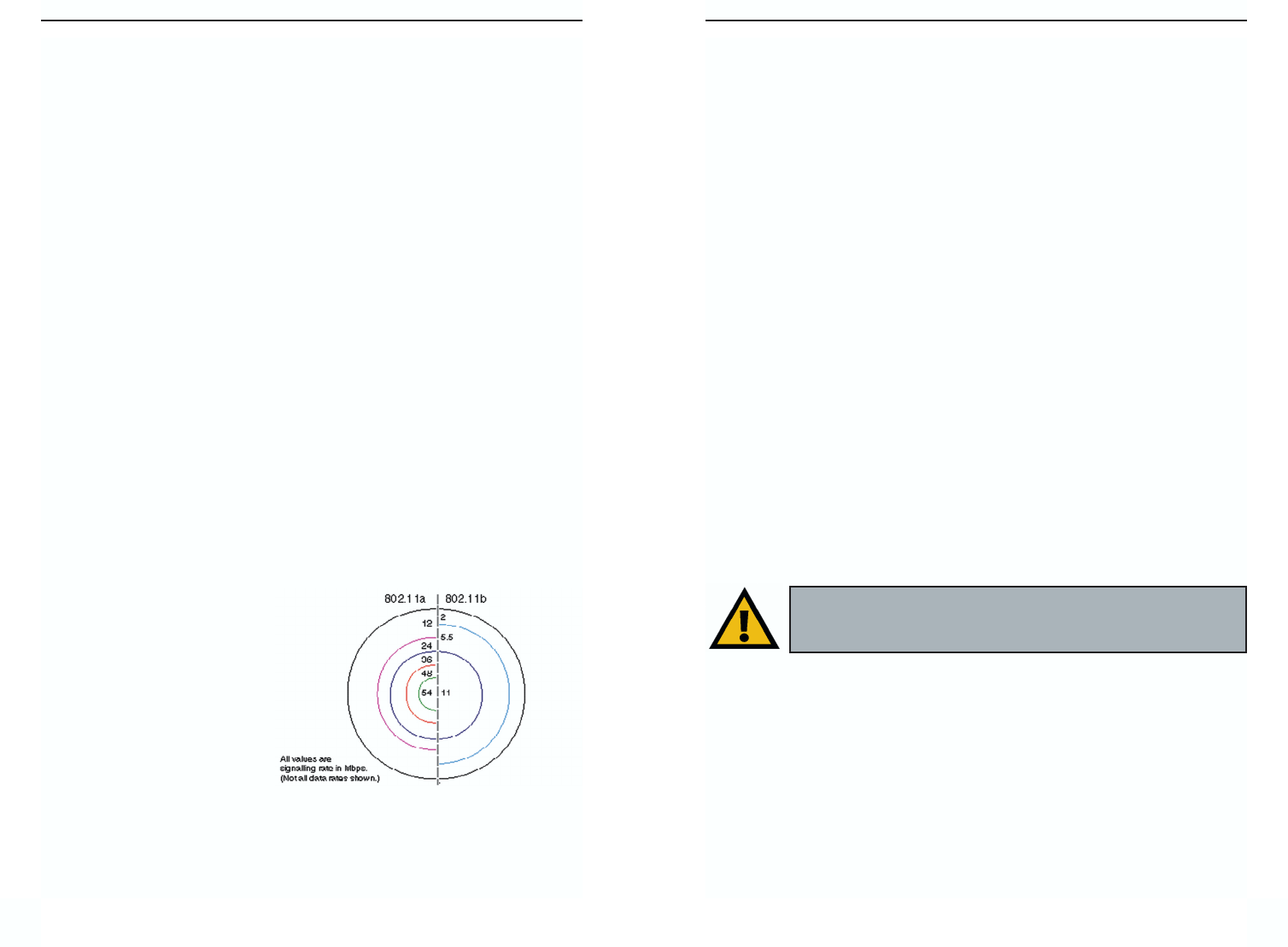
Dual-Band Wireless A+G Broadband Router
89
Appendix B: How to Ping Your ISP’s
E-mail & Web Addresses
Virtually all Internet addresses are configured with words or characters (e.g.,
www.linksys.com, www.yahoo.com, etc.) In actuality, however, these Internet
addresses are assigned to IP addresses, which are the true addresses on the
Internet. For example, www.yahoo.com is 66.218.71.87 (this IP address may
change). Type it into your web browser and you will wind up at the Linksys
home page every time. There are servers that translate the URL to an IP
address; this is called the Domain Name System (DNS).
IP and web addresses, however, can sometimes be long and hard to remember.
Because of this, certain ISPs will shorten their server addresses to single words
or codes on their users’ web browser or e-mail configurations. If your ISP’s e-
mail and web server addresses are configured with single words (www, e-mail,
home, pop3, etc.) rather than whole Internet addresses or IP addresses, the
Router may have problems sending or receiving mail and accessing the
Internet. This happens because the Router has not been configured by your ISP
to accept their abbreviated server addresses.
The solution is to determine the true web addresses behind your ISPs code
words. You can determine the IP and web addresses of your ISP’s servers by
“pinging” them.
Important: If you don’t have your ISP’s web and e-mail IP
addresses, you must either get them from your ISP or follow these
steps prior to connecting the Router to your network.
Instant Wireless®Series
88
How do I reset the Router?
Press the Reset button on the back panel for about ten seconds. This will reset
the Router to its default settings.
How do I resolve issues with signal loss?
There is no way to know the exact range of your wireless network without test-
ing. Every obstacle placed between the Router and a wireless PC will create
signal loss. Lead glass, metal, concrete floors, water and walls will inhibit the
signal and reduce range. Start with the Router and your wireless PC in the
same room and move it away in small increments to determine the maximum
range in your environment.
You may also try using different channels, as this may eliminate interference
affecting only one channel. Also, due to FCC regulations, more power may be
transmitted, using 802.11a, on channels 52, 56, 60 and 64, than on the lower
channels. Lastly, click the Advanced tab of the web-based utility and make
sure that FULL is selected in the Transmission Power field.
I have excellent signal strength, but I cannot see my network.
WEP is probably enabled on the Router, but not on your wireless adapter (or
vice versa). Verify that the same WEP keys and levels (64, 128, or 152) are
being used on all nodes of your wireless network.
How many channels/frequencies are available with the Router?
Using 802.11a, there are eight available channels, ranging from 36 to 64.
Using 802.11g-draft, there are eleven available channels, ranging from 1 to 11.
What is the difference in range
between 802.11a and 802.11g
products?
Overall, range will be a little
less in a typical environment,
and while higher speeds may be
achieved with 802.11a, through-
put degrades more quickly. (See
Figure A-1.)
If your questions are not addressed here, refer to the Linksys website,
www.linksys.com.
Figure A-1

Dual-Band Wireless A+G Broadband Router
9190
Step Two: Pinging for a Web Address
While the IP address returned above would work as your e-mail server address,
it may not be permanent. IP addresses change all the time. Web addresses, how-
ever, usually don’t. Because of this, you’re likely to have fewer problems by
configuring your system with web addresses rather than IP addresses. Follow
the instructions below to find the web address assigned to the IP address you
just pinged.
1. At the DOS command prompt, type ping -a 24.53.32.4, where 24.53.32.4
is the IP address you just pinged. Information such as the following data
will be displayed.
C:\>ping -a 24.53.32.4
Pinging mail.msnv3.occa.home.com [24.53.32.4] with
32 bytes of data:
Reply from 24.53.32.4: bytes=32 time<10ms TTL=127
Reply from 24.53.32.4: bytes=32 time<10ms TTL=127
Reply from 24.53.32.4: bytes=32 time<10ms TTL=127
Reply from 24.53.32.4: bytes=32 time<10ms TTL=127
Ping statistics for 24.53.32.4:
Packets: Sent = 4, Received = 4, Lost = 0 (0%
loss),
Approximate round trip times in milli-seconds:
Minimum = 0ms, Maximum = 0ms, Average = 0ms
2. Write down the web address returned by the ping command. (In the exam-
ple in Figure C-2, mail.msnv3.occa.home.com is the web address.) This
web address is the web address assigned to the IP address you just pinged.
While the IP address of mail could conceivably change, it is likely that this
web address will not.
3. Replace your ISP’s abbreviated server address with this extended web
address in the corresponding Internet application (web browser, e-mail
application, etc.).
Once you have replaced the brief server address with the true server address,
the Router should have no problem accessing the Internet through that Internet
application.
Figure B-2
Instant Wireless®Series
Step One: Pinging an IP Address
The first step to determining your ISP’s web and e-mail server address is to
ping its IP address.
1. Power on the computer and the cable or DSL modem, and restore the net-
work configuration set by your ISP if you have since changed it.
2. Click Start and then Run. Type command in the Open field. This will
bring up the DOS window.
3. At the DOS command prompt, type ping mail (assuming that the location
for which you’re trying to find an IP address is configured as mail). Press
the Enter key. Information such as the following data, taken from a ping of
Microsoft Network’s e-mail server, will be displayed.
C:\>ping mail
Pinging mail [24.53.32.4] with 32 bytes of data:
Reply from 24.53.32.4: bytes=32 time<10ms TTL=128
Reply from 24.53.32.4: bytes=32 time<10ms TTL=128
Reply from 24.53.32.4: bytes=32 time<10ms TTL=128
Reply from 24.53.32.4: bytes=32 time<10ms TTL=128
Ping statistics for 24.53.32.4:
Packets: Sent = 4, Received = 4, Lost = 0 (0%
loss),
Approximate round trip times in milli-seconds:
Minimum = 0ms, Maximum = 0ms, Average = 0ms
4. Write down the IP address returned by the ping command (in the example
above: 24.53.32.4.). This IP address is the actual IP address of the server
mail, or any other word or value you have pinged.
Figure B-1

Dual-Band Wireless A+G Broadband Router
9392
There are two types of WEP encryption for 802.1x, static and dynamic. Static
WEP keys are more vulnerable and can only be changed manually on all
devices, including the Router. If you are using MD5 authentication, then you
can only use static WEP keys. Dynamic WEP keys are keys that are renewed
automatically on a periodic basis. This makes the WEP key(s) more difficult to
break, so network security is strengthened. To enable dynamic WEP keys, you
must use 802.1x certificate-based authentication methods, such as TLS or
TTLS.
Make sure your wireless network is functioning before attempting to configure
WEP encryption.
On a wireless network, a 128-bit WEP encrypted device will NOT communi-
cate with a 64-bit WEP encrypted device. Therefore, make sure that all of the
wireless devices on each network are using the same encryption level.
In addition to enabling WEP, Linksys also recommends the following security
implementations:
•Change the SSID from the default “linksys”
•Change the SSID on a regular basis
•Change the WEP key regularly
•Enable MAC address filtering (if your wireless products allow it)
For instructions on how to configure the Router’s WEP settings, go to the
“Setup” section of “Chapter 7: The Router’s Web-Based Utility.” For instruc-
tions on how to configure the WEP settings of your PC’s wireless adapter, refer
to your wireless adapter’s documentation.
WEP Encryption
Instant Wireless®Series
Appendix C: Configuring Wireless
Security
The Router offers two wireless security features. The basic feature is Wired
Equivalent Privacy (WEP) encryption, an encryption method used to protect
your wireless data communications. WEP uses 64-bit, 128-bit, or 152-bit keys
to provide access control to your network and encryption security for every
data transmission. To decode a data transmission, each point in a network must
use an identical key. Higher encryption levels mean higher levels of security,
but due to the complexity of the encryption, they may mean decreased network
performance.
You may also have heard the term “40-bit” used in conjunction with WEP
encryption. This is simply another term for 64-bit WEP encryption. This level
of WEP encryption has been called 40-bit because it uses a 40-bit secret key
along with a 24-bit Initialization Vector (40 + 24 = 64). Wireless vendors may
use either name. Linksys uses the term “64-bit” when referring to this level of
encryption.
The second wireless security feature is 802.1x. The IEEE 802.1x standard spec-
ifies authentication methods for a wireless client, such as a PC, to access a net-
work, so network security is enhanced. Based on the Extensible Authentication
Protocol (EAP), 802.1x designates how a client accesses a network server, fre-
quently a RADIUS server, with the Router acting as an authenticator. When a
network uses 802.1x, the identity of the client is verified before the client is
allowed network access.
For example, a wireless user may use one of the authentication methods to
access a wireless network protected by an authentication server. The user’s PC
sends a request to the Router (an access point can be used instead). The Router
sends an identification request back to the PC. After the PC sends the Router the
identification message, the Router forwards the identification message to the
server. If the server accepts the identification message, then the PC is permitted
access to the wireless network.
Background
Note: WEP encryption is an additional data security measure and not
essential for router operation; however, Linksys recommends the use
of WEP encryption.
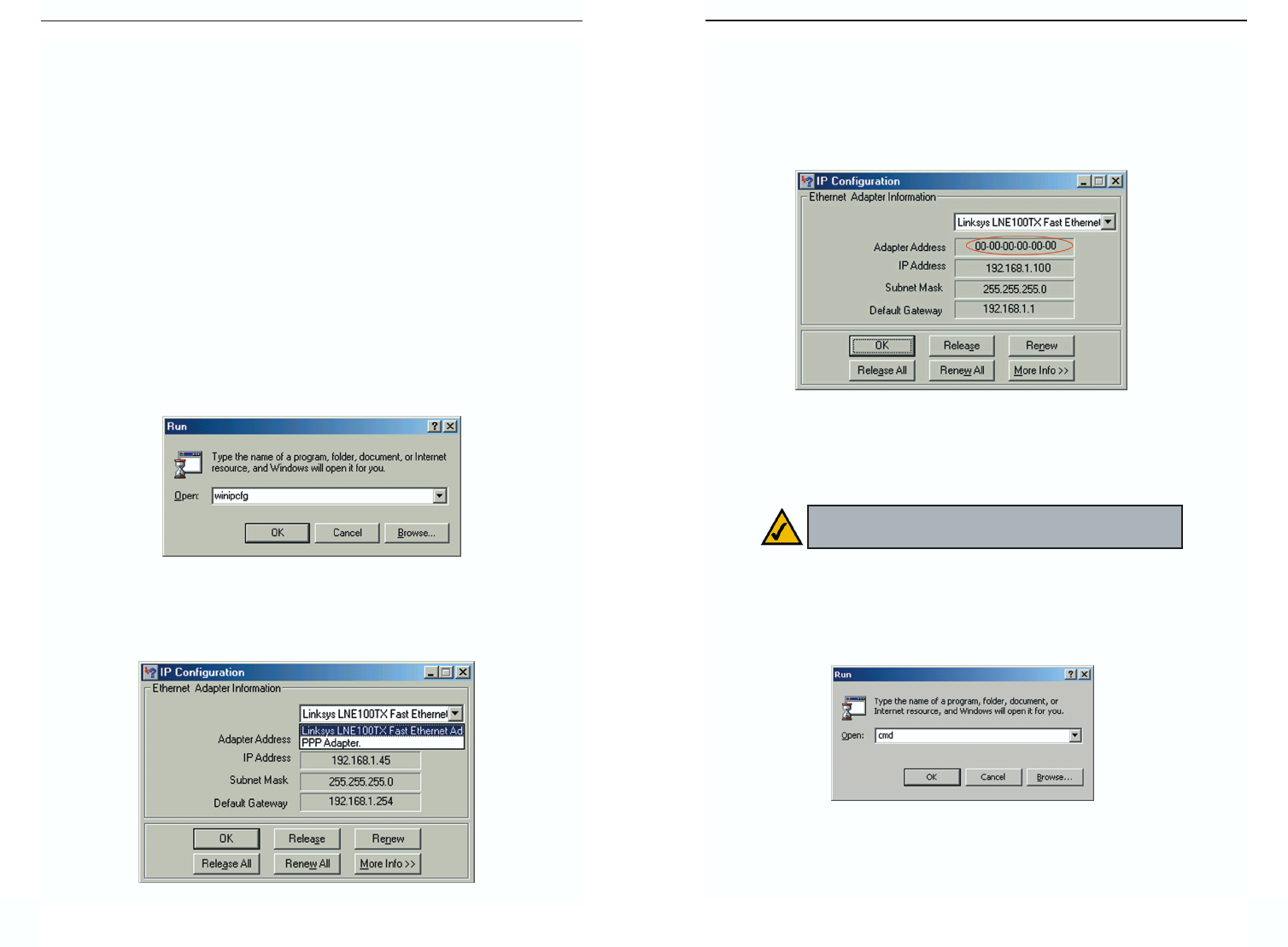
Dual-Band Wireless A+G Broadband Router
3. Write down the Adapter Address as shown on your computer screen (see
Figure E-3). This is the MAC address for your Ethernet adapter and will
be shown as a series of numbers and letters.
The MAC address/Adapter Address is what you will use for MAC address
cloning or MAC filtering.
Write down the IP Address as shown on your computer screen. The exam-
ple in Figure E-3 shows the IP address of your Ethernet adapter as
192.168.1.100. Your computer may show something different.
For Windows NT, 2000, and XP:
1. Click Start and Run. In the Open field, enter cmd. Press the Enter key or
click the OK button.
95
Appendix D: Finding the MAC
Address and IP Address for Your
Ethernet Adapter
This section describes how to find the MAC address for your Ethernet adapter
to do either MAC address filtering or MAC address cloning for the Router and
ISP. You can also find the IP address of your computer’s Ethernet adapter. The
IP address is used for filtering, forwarding, and DMZ. Follow the steps in this
appendix to find the MAC address or IP address for your adapter in Windows
95, 98, Me, NT, 2000, and XP.
For Windows 95, 98, and Me:
1. Click on Start and Run. In the Open field, enter winipcfg. Then press the
Enter key or the OK button.
2. When the IP Configuration window appears, select the Ethernet adapter
you are using to connect to the Router via a Category 5 Ethernet network
cable.
94
Figure D-3
Figure D-4
Note: The MAC address is also called the Adapter
Address.
Instant Wireless®Series
Figure D-1
Figure D-2
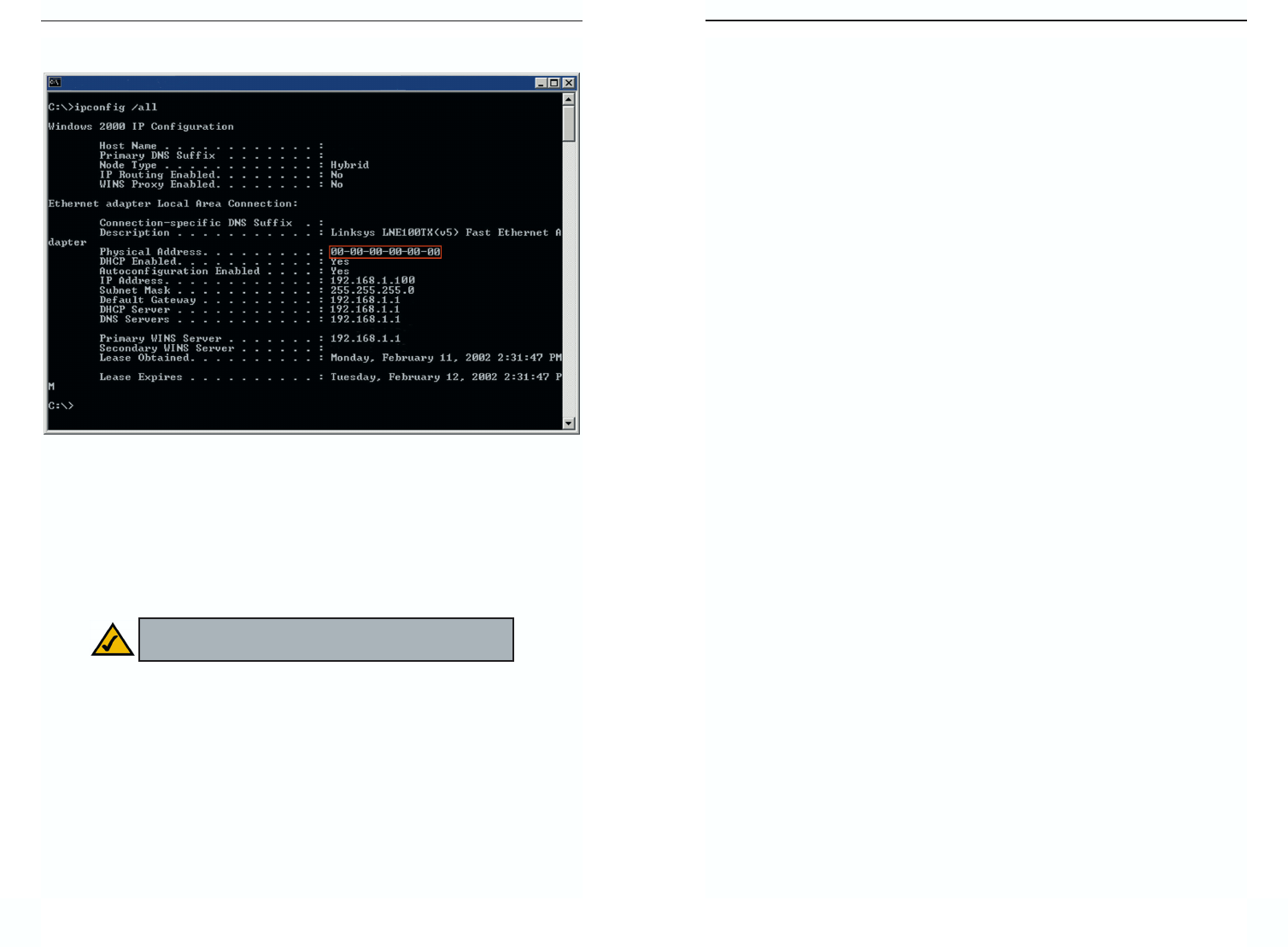
Dual-Band Wireless A+G Broadband Router
97
2. In the command prompt, enter ipconfig /all. Then press the Enter key.
3. Write down the Physical Address as shown on your computer screen; it is
the MAC address for your Ethernet adapter. This will appear as a series of
letters and numbers.
The MAC address/Physical Address is what you will use for MAC address
cloning or MAC filtering.
Write down the IP Address as shown on your computer screen. The exam-
ple in Figure E-5 shows the IP address of your Ethernet adapter as
192.168.1.100. Your computer may show something different.
96
Appendix E: Glossary
802.11a - One of the IEEE standards for wireless networking hardware.
Products that adhere to a specific IEEE standard will work with each other,
even if they are manufactured by different companies. It specifies a maximum
data transfer rate of 54Mbps and an operating frequency of 5GHz. The 802.11a
standard uses the Orthogonal Frequency Division Multiplexing (OFDM) trans-
mission method. Additionally, the 802.11a standard supports 802.11 features
such as WEP encryption for security.
802.11b - One of the IEEE standards for wireless networking hardware.
Products that adhere to a specific IEEE standard will work with each other,
even if they are manufactured by different companies. The 802.11b standard
specifies a maximum data transfer rate of 11Mbps, an operating frequency of
2.4GHz, and WEP encryption for security. 802.11b networks are also referred
to as Wi-Fi networks.
802.11g - A proposed, but as yet unratified extension of the IEEE 802.11 stan-
dard for wireless networking hardware. The draft 802.11g specifications used
by Linksys specify a maximum data transfer rate of 54Mbps using OFDM
modulation, an operating frequency of 2.4GHz, backward compatibility with
IEEE 802.11b devices, and WEP encryption for security.
802.1x - Based on the Extensible Authentication Protocol (EAP), the 802.1x
standard is one of the IEEE standards for network authentication and key man-
agement. It establishes a framework that supports multiple authentication meth-
ods. This standard can be incorporated into any type of network to enhance its
security.
For example, a wireless user may use one of the authentication methods to
access a wireless network protected by an authentication server. The user, also
called the supplicant, sends a request to an access point or wireless router, also
called the authenticator. The authenticator sends an identification request back
to the user. After the user sends the authenticator the identification message,
the authenticator forwards the user's identification message to the authentica-
tion server. If the server accepts the identification message, then the user is per-
mitted access to the wireless network. The 802.1x standard can also support
encryption key management to strengthen wireless network encryption servic-
es.
Instant Wireless®Series
Figure D-5
Note: The MAC address is also called the Physical
Address.

Dual-Band Wireless A+G Broadband Router
99
Adapter - Printed circuit board that plugs into a PC to add to capabilities or
connectivity to a PC. In a networked environment, a network interface card is
the typical adapter that allows the PC or server to connect to the intranet and/or
Internet.
Ad-hoc Network - An ad-hoc network is a group of computers, each with a
wireless adapter, connected as an independent 802.11 wireless LAN. Ad-hoc
wireless computers operate on a peer-to-peer basis, communicating directly
with each other without the use of an access point. Ad-hoc mode is also
referred to as an Independent Basic Service Set or as peer-to-peer mode.
ADSL (Asymmetric Digital Subscriber Line) - A technology for transmitting
digital information at a high bandwidth on existing phone lines to homes and
businesses. Unlike regular dialup phone service, ADSL provides continuously-
available, "always on" connection. ADSL is asymmetric in that it uses most of
the channel to transmit downstream to the user and only a small part to receive
information from the user. ADSL simultaneously accommodates analog (voice)
information on the same line. ADSL is generally offered at downstream data
rates from 144 Kbps to about 6 Mbps. A form of ADSL, known as Universal
ADSL or G.lite, has been approved as a standard by the ITU-TS.
ADSL was specifically designed to exploit the one-way nature of most multi-
media communication in which large amounts of information flow toward the
user and only a small amount of interactive control information is returned.
Several experiments with ADSL to real users began in 1996. In 1998, wide-
scale installations began in several parts of the U.S. In 2000 and beyond, ADSL
and other forms of DSL are expected to become generally available in urban
areas. With ADSL (and other forms of DSL), telephone companies are com-
peting with cable companies and their cable modem services.
AppleTalk - An Apple Computer networking system that supports Apple's pro-
prietary local talk.
Auto-MDI/MDIX - On a network hub or switch, an auto-MDI/MDIX port
automatically senses if it needs to act as a MDI or MDIX port. The auto-
MDI/MDIX capability eliminates the need for crossover cables.
Auto-negotiate - To automatically determine the correct settings. The term is
often used with communications and networking. For example, Ethernet
10/100 cards, hubs and switches can determine the highest speed of the node
they are connected to and adjust their transmission rate accordingly.
98
Backbone - The part of a network that connects most of the systems and net-
works together and handles the most data.
Bandwidth - The transmission capacity of a given facility, in terms of how
much data the facility can transmit in a fixed amount of time; expressed in bits
per second (bps).
Beacon Interval - A beacon is a packet broadcast by the Access Point to keep
the network synchronized. A beacon includes the wireless LAN service area,
the AP address, the Broadcast destination addresses, a time stamp, Delivery
Traffic Indicator Maps, and the Traffic Indicator Message (TIM).
Bit - A binary digit. The value - 0 or 1-used in the binary numbering system.
Also, the smallest form of data.
Boot - To cause the computer to start executing instructions. Personal comput-
ers contain built-in instructions in a ROM chip that are automatically executed
on startup. These instructions search for the operating system, load it and pass
control to it.
Broadband - A data-transmission scheme in which multiple signals share the
bandwidth of a medium. This allows the transmission of voice, data and video
signals over a single medium. Cable television uses broadband techniques to
deliver dozens of channels over one cable.
Browser - A browser is an application program that provides a way to look at
and interact with all the information on the World Wide Web or PC. The word
"browser" seems to have originated prior to the Web as a generic term for user
interfaces that let you browse text files online.
Buffer - A buffer is a shared or assigned memory area used by hardware
devices or program processes that operate at different speeds or with different
sets of priorities. The buffer allows each device or process to operate without
being held up by the other. In order for a buffer to be effective, the size of the
buffer and the algorithms for moving data into and out of the buffer need to be
considered by the buffer designer. Like a cache, a buffer is a "midpoint holding
place" but exists not so much to accelerate the speed of an activity as to sup-
port the coordination of separate activities.
Cable Modem - A device that connects a computer to the cable television net-
work, which in turn connects to the Internet. Once connected, cable modem
users have a continuous connection to the Internet. Cable modems feature
Instant Wireless®Series

Dual-Band Wireless A+G Broadband Router
101
asymmetric transfer rates: around 36 Mbps downstream (from the Internet to
the computer), and from 200 Kbps to 2 Mbps upstream (from the computer to
the Internet).
CAT 5 - ANSI/EIA (American National Standards Institute/Electronic
Industries Association) Standard 568 is one of several standards that specify
"categories" (the singular is commonly referred to as "CAT") of twisted pair
cabling systems (wires, junctions, and connectors) in terms of the data rates
that they can sustain. CAT 5 cable has a maximum throughput of 100 Mbps and
is usually utilized for 100BaseTX networks.
Cookie - Data created by a Web server that is stored on a user's computer. It
provides a way for the Web site to keep track of a user's patterns and prefer-
ences and, with the cooperation of the Web browser, to store them on the user's
own hard disk.
CSMA/CA (Carrier Sense Multiple Access/Collision Avoidance) - In local
area networking, this is the CSMA technique that combines slotted time-divi-
sion multiplexing with carrier sense multiple access/collision detection
(CSMA/CD) to avoid having collisions occur a second time. This works best if
the time allocated is short compared to packet length and if the number of sit-
uations is small.
CTS (Clear To Send) - An RS-232 signal sent from the receiving station to the
transmitting station that indicates it is ready to accept data.
Daisy Chain - Connected in series, one after the other. Transmitted signals go
to the first device, then to the second and so on.
DDNS (Dynamic Domain Name System) - Allows a network device with a
dynamic Internet IP address to have a fixed host and domain name, such as
myhostname.mydomainname.com. It is useful when you are hosting your own
website, FTP server, or other server behind a router, so people can find your
site no matter how often the Internet IP address changes. Using DDNS requires
registering with a DDNS service provider on the Internet.
Default Gateway - The routing device used to forward all traffic that is not
addressed to a station within the local subnet.
DHCP (Dynamic Host Configuration Protocol) - A protocol that lets network
administrators manage centrally and automate the assignment of Internet
Protocol (IP) addresses in an organization's network. Using the Internet's set of
100
protocol (TCP/IP), each machine that can connect to the Internet needs a
unique IP address. When an organization sets up its computer users with a con-
nection to the Internet, an IP address must be assigned to each machine.
Without DHCP, the IP address must be entered manually at each computer and,
if computers move to another location in another part of the network, a new IP
address must be entered. DHCP lets a network administrator supervise and dis-
tribute IP addresses from a central point and automatically sends a new IP
address when a computer is plugged into a different place in the network.
DHCP uses the concept of a "lease" or amount of time that a given IP address
will be valid for a computer. The lease time can vary depending on how long a
user is likely to require the Internet connection at a particular location. It's espe-
cially useful in education and other environments where users change fre-
quently. Using very short leases, DHCP can dynamically reconfigure networks
in which there are more computers than there are available IP addresses.
DHCP supports static addresses for computers containing Web servers that
need a permanent IP address.
DMZ (Demilitarized Zone) - Allows one IP address (or computer) to be
exposed to the Internet. Some applications require multiple TCP/IP ports to be
open. You should set your computer with a static IP address if you want to use
DMZ Hosting.
DNS - The domain name system (DNS) is the way that Internet domain name
are located and translated into Internet Protocol (IP) addresses. A domain name
is a meaningful and easy-to-remember "handle" for an Internet address.
Domain - A subnetwork comprised of a group of clients and servers under the
control of one security database. Dividing LANs into domains improves per-
formance and security.
Download - To receive a file transmitted over a network. In a communications
session, download means receive, upload means transmit.
DSL (Digital Subscriber Line) - A technology that dramatically increases the
digital capacity of ordinary telephone lines into the home or office and, by
employing unused bandwidth, still allows for normal phone usage. DSL pro-
vides "always-on" operation, eliminating the need to dial in to the service.
DSSS (Direct-Sequence Spread Spectrum) - DSSS generates a redundant bit
pattern for all data transmitted. This bit pattern is called a chip (or chipping
Instant Wireless®Series

Dual-Band Wireless A+G Broadband Router
103
code). Even if one or more bits in the chip are damaged during transmission,
statistical techniques embedded in the receiver can recover the original data
without the need for retransmission. To an unintended receiver, DSSS appears
as low power wideband noise and is rejected (ignored) by most narrowband
receivers. However, to an intended receiver (i.e. another wireless LAN end-
point), the DSSS signal is recognized as the only valid signal, and interference
is inherently rejected (ignored).
DTIM (Delivery Traffic Indication Message) - A DTIM field is a countdown
field informing clients of the next window for listening to broadcast and mul-
ticast messages. When the AP has buffered broadcast or multicast messages for
associated clients, it sends the next DTIM with a DTIM Interval value. AP
Clients hear the beacons and awaken to receive the broadcast and multicast
messages.
Dynamic IP Address - An IP address that is automatically assigned to a client
station in a TCP/IP network, typically by a DHCP server. Network devices that
serve multiple users, such as servers and printers, are usually assigned static IP
addresses.
Dynamic Routing - The ability for a router to forward data via a different route
based on the current conditions of the communications circuits. For example,
it can adjust for overloaded traffic or failing lines and is much more flexible
than static routing, which uses a fixed forwarding path.
EAP (Extensible Authentication Protocol) - An IETF standard that establishes
an authentication protocol for network access. Many authentication methods,
including passwords, certificates, and smart cards, work within this framework.
Encryption - A security method that applies a specific algorithm to data in
order to alter the data's appearance and prevent other devices from reading the
information.
Ethernet - IEEE standard network protocol that specifies how data is placed
on and retrieved from a common transmission medium. Has a transfer rate of
10 Mbps. Forms the underlying transport vehicle used by several upper-level
protocols, including TCP/IP and XNS.
Fast Ethernet - A 100 Mbps technology based on the 10Base-T Ethernet
CSMA/CD network access method.
102
FHSS (Frequency Hopping Spread Spectrum) - FHSS continuously changes
(hops) the carrier frequency of a conventional carrier several times per second
according to a pseudo-random set of channels. Because a fixed frequency is not
used, and only the transmitter and receiver know the hop patterns, interception
of FHSS is extremely difficult.
Finger - A UNIX command widely used on the Internet to find out informa-
tion about a particular user, such as telephone number, whether currently
logged on or the last time logged on. The person being "fingered" must have
placed his or her profile on the system. Fingering requires entering the full
user@domain address.
Firewall - A firewall is a set of related programs, located at a network gateway
server, that protects the resources of a network from users from other networks.
(The term also implies the security policy that is used with the programs.) An
enterprise with an intranet that allows its workers access to the wider Internet
installs a firewall to prevent outsiders from accessing its own private data
resources and for controlling what outside resources to which its own users
have access.
Basically, a firewall, working closely with a router, examines each network
packet to determine whether to forward it toward its destination.
Firmware - Code that is written onto read-only memory (ROM) or program-
mable read-only memory (PROM). Once firmware has been written onto the
ROM or PROM, it is retained even when the device is turned off.
Fragmentation - Breaking a packet into smaller units when transmitting over
a network medium that cannot support the original size of the packet.
FTP (File Transfer Protocol) - A protocol used to transfer files over a TCP/IP
network (Internet, UNIX, etc.). For example, after developing the HTML pages
for a Web site on a local machine, they are typically uploaded to the Web serv-
er using FTP.
FTP includes functions to log onto the network, list directories and copy files.
It can also convert between the ASCII and EBCDIC character codes. FTP oper-
ations can be performed by typing commands at a command prompt or via an
FTP utility running under a graphical interface such as Windows. FTP transfers
can also be initiated from within a Web browser by entering the URL preceded
with ftp://.
Instant Wireless®Series

Dual-Band Wireless A+G Broadband Router
105
Unlike e-mail programs in which graphics and program files have to be
"attached," FTP is designed to handle binary files directly and does not add the
overhead of encoding and decoding the data.
Full Duplex - The ability of a device or line to transmit data simultaneously in
both directions.
Gateway - A device that interconnects networks with different, incompatible
communications protocols.
Half Duplex - Data transmission that can occur in two directions over a single
line, but only one direction at a time.
Hardware - Hardware is the physical aspect of computers, telecommunica-
tions, and other information technology devices. The term arose as a way to dis-
tinguish the "box" and the electronic circuitry and components of a computer
from the program you put in it to make it do things. The program came to be
known as the software.
Hop - The link between two network nodes.
HTTP (HyperText Transport Protocol) - The communications protocol used
to connect to servers on the World Wide Web. Its primary function is to estab-
lish a connection with a Web server and transmit HTML pages to the client
browser.
Hub - The device that serves as the central location for attaching wires from
workstations. Can be passive, where there is no amplification of the signals; or
active, where the hubs are used like repeaters to provide an extension of the
cable that connects to a workstation.
ICQ - A conferencing program for the Internet that provides interactive chat,
e-mail and file transfer and can alert you when someone on your predefined list
has also come online.
IEEE (The Institute of Electrical and Electronics Engineers) - The IEEE
describes itself as "the world's largest technical professional society, promoting
the development and application of electrotechnology and allied sciences for
the benefit of humanity, the advancement of the profession, and the well-being
of our members."
104
The IEEE fosters the development of standards that often become national and
international standards. The organization publishes a number of journals, has
many local chapters, and several large societies in special areas, such as the
IEEE Computer Society.
Infrastructure Network - An infrastructure network is a group of computers
or other devices, each with a wireless adapter, connected as an 802.11 wireless
LAN. In infrastructure mode, the wireless devices communicate with each
other and to a wired network by first going through an access point. An infra-
structure wireless network connected to a wired network is referred to as a
Basic Service Set (BSS). A set of two or more BSS in a single network is
referred to as an Extended Service Set (ESS). Infrastructure mode is useful at
a corporation scale, or when it is necessary to connect the wired and wireless
networks.
IP (Internet Protocol) - The method or protocol by which data is sent from one
computer to another on the Internet. It is a standard set of rules, procedures, or
conventions relating to the format and timing of data transmission between two
computers that they must accept and use to be able to understand each other.
IP Address - In the most widely installed level of the Internet Protocol (IP)
today, an IP address is a 32-binary digit number that identifies each sender or
receiver of information that is sent in packet across the Internet. When you
request an HTML page or send e-mail, the Internet Protocol part of TCP/IP
includes your IP address in the message (actually, in each of the packets if more
than one is required) and sends it to the IP address that is obtained by looking
up the domain name in the Uniform Resource Locator you requested or in the
e-mail address you're sending a note to. At the other end, the recipient can see
the IP address of the Web page requestor or the e-mail sender and can respond
by sending another message using the IP address it received.
IPCONFIG - A Windows NT or 2000 utility that provides for querying, defin-
ing and managing IP addresses within a network. A commonly used utility for
configuring networks with static IP addresses.
IPSec (Internet Protocol Security) - A suite of protocols used to implement
secure exchange of packets at the IP layer. IPSec supports two basic modes:
Transport and Tunnel. Transport encrypts the payload of each packet, leaving
the header untouched, while Tunnel mode encrypts both the header and the pay-
load and is therefore more secure. IPSec must be supported on both transmit-
ter and receiver and must share a public key. Tunnel mode is widely deployed
in VPNs (Virtual Private Networks).
Instant Wireless®Series

Dual-Band Wireless A+G Broadband Router
107
IPX (Internetwork Packet EXchange) - A NetWare communications protocol
used to route messages from one node to another. IPX packets include network
addresses and can be routed from one network to another.
ISM band - The FCC and their counterparts outside of the U.S. have set aside
bandwidth for unlicensed use in the ISM (Industrial, Scientific and Medical)
band. Spectrum in the vicinity of 2.4 GHz, in particular, is being made avail-
able worldwide. This presents a truly revolutionary opportunity to place con-
venient high-speed wireless capabilities in the hands of users around the globe.
ISP (Internet Service Provider) - A company that provides individuals and
companies access to the Internet and other related services such as Web site
building and virtual hosting.
LAN (Local Area Network) - A group of computers and associated devices that
share a common communications line and typically share the resources of a
single processor or server within a small geographic area (for example, within
an office building).
Layer 2 - Data Link layer in the International Standards Organization (ISO) 7-
Layer Data Communications Protocol, also known as the OSI (Open Systems
Interconnection) model. This is a standard model to consult when designing
network protocols. Layer 2 is directly related to the hardware interface for net-
work devices and passes traffic based on MAC addresses.
MAC (Media Access Control) Address - A unique number assigned by the
manufacturer to any Ethernet networking device, such as a network adapter,
that allows the network to identify it at the hardware level.
Mbps (Megabits per second) - One million bits per second; unit of measure-
ment for data transmission.
MD5 - A type of one-way authentication method that uses passwords. MD5
authentication is not as secure as the EAP-TLS or EAP/TTLS authentication
methods. MD5 authentication does not support dynamic WEP key manage-
ment.
MDI (Medium Dependent Interface) - On a network hub or switch, a MDI
port, also known as an uplink port, connects to another hub or switch using a
straight-through cable. To connect a MDI port to a computer, use a crossover
cable.
106
MDIX (Medium Dependent Interface Crossed) - On a network hub or switch,
a MDIX port connects to a computer using a straight-through cable. To connect
a MDIX port to another hub or switch, use a crossover cable.
mIRC - mIRC runs under Windows and provides a graphical interface for log-
ging onto IRC servers and listing, joining and leaving channels.
Multicasting - Sending data to a group of nodes instead of a single destination.
NAT (Network Address Translation) - The translation of an Internet Protocol
address (IP address) used within one network to a different IP address known
within another network. One network is designated the inside network and the
other is the outside.
Network - A system that transmits any combination of voice, video and/or data
between users.
NNTP (Network News Transfer Protocol) - The protocol used to connect to
Usenet groups on the Internet. Usenet newsreaders support the NNTP protocol.
Node - A network junction or connection point, typically a computer or work
station.
Notebook (PC) - A notebook computer is a battery-powered personal comput-
er generally smaller than a briefcase that can easily be transported and conve-
niently used in temporary spaces such as on airplanes, in libraries, temporary
offices, and at meetings. A notebook computer, sometimes called a laptop com-
puter, typically weighs less than five pounds and is three inches or less in thick-
ness.
OFDM - Developed for wireless applications, Orthogonal Frequency Division
Multiplexing (OFDM) technology offers superior performance-increased data
rates and more reliable transmissions-than previous technologies, such as
DSSS. OFDM is a scheme in which numerous signals of different frequencies
are combined to form a single signal for transmission on the medium.
OFDM works by breaking one high-speed data stream into a number of lower-
speed data streams, which are then transmitted in parallel. Each lower speed
stream is used to modulate a subcarrier. Essentially, this creates a multi-carrier
transmission by dividing a wide frequency band or channel into a number of
narrower frequency bands or sub-channels. OFDM is also used for other appli-
cations, including powerline networking.
Instant Wireless®Series

Dual-Band Wireless A+G Broadband Router
109108
used in 802.1x implementations; however, they are not specified by the 802.1x
standard.
RJ-45 (Registered Jack-45) - A connector similar to a telephone connector that
holds up to eight wires, used for connecting Ethernet devices.
RMON (Remote MONitoring) - RMON provides comprehensive network
monitoring capabilities. It eliminates the polling required in standard SNMP,
and can set alarms on a variety of traffic conditions, including specific error
types.
Roaming - In an infrastructure mode wireless network, this refers to the abili-
ty to move out of one access point's range and into another and transparently
reassociate and reauthenticate to the new access point. This reassociation and
reauthentication should occur without user intervention and ideally without
interruption to network connectivity. A typical scenario would be a location
with multiple access points, where users can physically relocate from one area
to another and easily maintain connectivity.
Router - Protocol-dependent device that connects subnetworks together.
Routers are useful in breaking down a very large network into smaller subnet-
works; they introduce longer delays and typically have much lower throughput
rates than bridges.
RTS (Request To Send) - An RS-232 signal sent from the transmitting station
to the receiving station requesting permission to transmit.
Server - Any computer whose function in a network is to provide user access
to files, printing, communications, and other services.
SMTP (Simple Mail Transfer Protocol) - The standard e-mail protocol on the
Internet. It is a TCP/IP protocol that defines the message format and the mes-
sage transfer agent (MTA), which stores and forwards the mail.
SNMP (Simple Network Management Protocol) - A widely used network
monitoring and control protocol. Data is passed from SNMP agents, which are
hardware and/or software processes reporting activity in each network device
(hub, router, bridge, etc.) to the workstation console used to oversee the net-
work. The agents return information contained in a MIB (Management
Information Base), which is a data structure that defines what is obtainable
from the device and what can be controlled (turned off, on, etc.).
Instant Wireless®Series
Packet - A unit of data routed between an origin and a destination in a network.
Passphrase - Used much like a password, a passphrase simplifies the WEP
encryption process by automatically generating the WEP encryption keys for
Linksys products.
Ping (Packet INternet Groper) - An Internet utility used to determine whether
a particular IP address is online. It is used to test and debug a network by send-
ing out a packet and waiting for a response.
POP3 (Post Office Protocol 3) - A standard mail server commonly used on the
Internet. It provides a message store that holds incoming e-mail until users log
on and download it. POP3 is a simple system with little selectivity. All pending
messages and attachments are downloaded at the same time. POP3 uses the
SMTP messaging protocol.
Port - A pathway into and out of the computer or a network device such as a
switch or router. For example, the serial and parallel ports on a personal com-
puter are external sockets for plugging in communications lines, modems and
printers.
PPPoE (Point to Point Protocol over Ethernet) - PPPoE is a method for the
encapsulation of PPP packets over Ethernet frames from the user to the ISP
over the Internet. One reason PPPoE is preferred by ISPs is because it provides
authentication (username and password) in addition to data transport. A PPPoE
session can be initiated by either a client application residing on a PC, or by
client firmware residing on a modem or router.
PPTP (Point-to-Point Tunneling Protocol) - A protocol which allows the Point
to Point Protocol (PPP) to be tunneled through an IP network. PPTP does not
specify any changes to the PPP protocol but rather describes a "tunneling serv-
ice" for carrying PPP (a tunneling service is any network service enabled by
tunneling protocols such as PPTP, L2F, L2TP, and IPSEC tunnel mode). One
example of a tunneling service is secure access from a remote small office net-
work to a headquarters corporate intranet via a Virtual Private Network (VPN)
that traverses the Internet. However, tunneling services are not restricted to cor-
porate environments and may also be used for personal (i.e., non-business)
applications.
RADIUS (Remote Authentication Dial-In User Service) - A protocol used to
control network access. RADIUS enables servers to authenticate users, so only
legitimate users are granted network access. RADIUS servers are frequently

Dual-Band Wireless A+G Broadband Router
TCP (Transmission Control Protocol) - A method (protocol) used along with
the IP (Internet Protocol) to send data in the form of message units (datagram)
between network devices over a LAN or WAN. While IP takes care of handling
the actual delivery of the data (routing), TCP takes care of keeping track of the
individual units of data (called packets) that a message is divided into for effi-
cient delivery over the network. TCP is known as a "connection oriented" pro-
tocol due to requiring the receiver of a packet to return an acknowledgment of
receipt to the sender of the packet resulting in transmission control.
TCP/IP (Transmission Control Protocol/Internet Protocol) - The basic com-
munication language or set of protocols for communications over a network
(developed specifically for the Internet). TCP/IP defines a suite or group of
protocols and not only TCP and IP.
Telnet - A terminal emulation protocol commonly used on the Internet and
TCP/IP-based networks. It allows a user at a terminal or computer to log onto
a remote device and run a program.
TFTP (Trivial File Transfer Protocol) - A version of the TCP/IP FTP protocol
that has no directory or password capability.
Throughput - The amount of data moved successfully from one place to
another in a given time period.
UDP (User Datagram Protocol) - A method (protocol) used along with the IP
(Internet Protocol) to send data in the form of message units (datagram)
between network devices over a LAN or WAN. While IP takes care of handling
the actual delivery of the data (routing), UDP takes care of keeping track of the
individual units of data (called packets) that a message is divided into for effi-
cient delivery over the network. UDP is known as a "connection-less" protocol
due to NOT requiring the receiver of a packet to return an acknowledgment of
receipt to the sender of the packet (as opposed to TCP).
Upgrade - To replace existing software or firmware with a newer version.
Upload - To transmit a file over a network. In a communications session,
upload means transmit, download means receive.
URL (Uniform Resource Locator) - The address that defines the route to a file
on the Web or any other Internet facility. URLs are typed into the browser to
access Web pages, and URLs are embedded within the pages themselves to pro-
vide the hypertext links to other pages.
111
Software - Instructions for the computer. A series of instructions that performs
a particular task is called a "program." The two major categories of software are
"system software" and "application software." System software is made up of
control programs such as the operating system and database management sys-
tem (DBMS). Application software is any program that processes data for the
user.
A common misconception is that software is data. It is not. Software tells the
hardware how to process the data.
Spread Spectrum - Spread Spectrum technology is a wideband radio frequen-
cy technique developed by the military for use in reliable, secure, mission-crit-
ical communications systems. It is designed to trade off bandwidth efficiency
for reliability, integrity, and security. In other words, more bandwidth is con-
sumed than in the case of narrowband transmission, but the trade off produces
a signal that is, in effect, louder and thus easier to detect, provided that the
receiver knows the parameters of the spread-spectrum signal being broadcast.
If a receiver is not tuned to the right frequency, a spread-spectrum signal looks
like background noise. There are two main alternatives, Direct Sequence
Spread Spectrum (DSSS) and Frequency Hopping Spread Spectrum (FHSS).
SSID (Service Set IDentifier) - A unique name shared among all points in a
wireless network. The SSID must be identical for each point in the wireless net-
work and is case-sensitive.
Static IP Address - A permanent IP address that is assigned to a node in an IP
or a TCP/IP network.
Static Routing - Forwarding data in a network via a fixed path. Static routing
cannot adjust to changing line conditions as can dynamic routing.
Storage - The semi-permanent or permanent holding place for digital data.
Subnet Mask - The method used for splitting IP networks into a series of sub-
groups, or subnets. The mask is a binary pattern that is matched up with the IP
address to turn part of the host ID address field into a field for subnets.
Switch - 1. A data switch connects computing devices to host computers,
allowing a large number of devices to share a limited number of ports. 2. A
device for making, breaking, or changing the connections in an electrical cir-
cuit.
110
Instant Wireless®Series

Dual-Band Wireless A+G Broadband Router
113
Appendix F: Specifications
Standards 802.11a, 802.11b, draft 802.11g
Ports
Internet: One 10/100 RJ-45 Port for Cable/DSL Modem
LAN: Four 10/100 RJ-45 Switched Ports
Buttons One Reset Button and One Power Port
Cabling Type UTP Category 5 or better
LEDs Power, Diag
Internet: Link/Act, 100
LAN: Link/Act, Full/Col, 100
802.11a: Act, Link
54g: Act, Link
VPN (Virtual Private Network) - A technique that allows two or more LANs to
be extended over public communication channels by creating private commu-
nication subchannels (tunnels). Effectively, these LANs can use a WAN as a
single large "virtually private" LAN. This removes the need to use leased lines
for WAN communications through secure use of a publicly available WAN
(such as the Internet). Examples of VPN technology are: PPTP (Point to Point
Tunneling Protocol), L2TP (Layer 2 Tunneling Protocol), and IPSec (Internet
Protocol Security).
WA N (Wide Area Network)- A communications network that covers a rela-
tively large geographic area, consisting of two or more LANs. Broadband com-
munication over the WAN is often through public networks such as the tele-
phone (DSL) or cable systems, or through leased lines or satellites. In its most
basic definition, the Internet could be considered a WAN.
WEP (Wired Equivalent Privacy) - A data privacy mechanism based on a 64-
bit or 128-bit shared key algorithm, as described in the IEEE 802.11 standard.
WINIPCFG - Configuration utility based on the Win32 API for querying,
defining and managing IP addresses within a network. A commonly used util-
ity for configuring networks with static IP addresses.
WLAN (Wireless Local Area Network) - A group of computers and associat-
ed devices that communicate with each other wirelessly.
112
Instant Wireless®Series

Dual-Band Wireless A+G Broadband Router
115
Dimensions 7.32" x 1.89" x 6.89"
(186 mm x 48 mm x 175 mm)
Unit Weight 0.88 lbs. (0.4 kg)
Power External, 5V DC, 2.5A
Certifications FCC, CE Marking, Wi-Fi
Operating Temp. 32ºF to 104ºF (0ºC to 40ºC)
Storage Temp. -4ºF to 158ºF (-20ºC to 70ºC)
Operating Humidity 10% to 85%, Non-Condensing
Storage Humidity 5% to 90%, Non-Condensing
114
Appendix G: Warranty Information
BE SURE TO HAVE YOUR PROOF OF PURCHASE AND A BARCODE
FROM THE PRODUCT'S PACKAGING ON HAND WHEN CALLING.
RETURN REQUESTS CANNOT BE PROCESSED WITHOUT PROOF OF
PURCHASE.
IN NO EVENT SHALL LINKSYS’S LIABILITY EXCEED THE PRICE
PAID FOR THE PRODUCT FROM DIRECT, INDIRECT, SPECIAL, INCI-
DENTAL, OR CONSEQUENTIAL DAMAGES RESULTING FROM THE
USE OF THE PRODUCT, ITS ACCOMPANYING SOFTWARE, OR ITS
DOCUMENTATION. LINKSYS DOES NOT OFFER REFUNDS FOR ANY
PRODUCT.
LINKSYS OFFERS CROSS SHIPMENTS, A FASTER PROCESS FOR PRO-
CESSING AND RECEIVING YOUR REPLACEMENT. LINKSYS PAYS
FOR UPS GROUND ONLY. ALL CUSTOMERS LOCATED OUTSIDE OF
THE UNITED STATES OF AMERICA AND CANADA SHALL BE HELD
RESPONSIBLE FOR SHIPPING AND HANDLING CHARGES. PLEASE
CALL LINKSYS FOR MORE DETAILS.
Instant Wireless®Series
Environmental

Appendix H: Contact Information
For help with the installation or operation of the Dual-Band Wireless A+G
Broadband Router, contact Linksys Technical Support at one of the phone num-
bers or Internet addresses below.
Sales Information 800-546-5797 (1-800-LINKSYS)
Technical Support 800-326-7114
RMA Issues 949-271-5461
Fax 949-265-6655
Email support@linksys.com
Web site http://www.linksys.com
FTP site ftp://ftp.linksys.com
116
© Copyright 2003 Linksys, All Rights Reserved.
www.linksys.com
Instant Wireless®Series